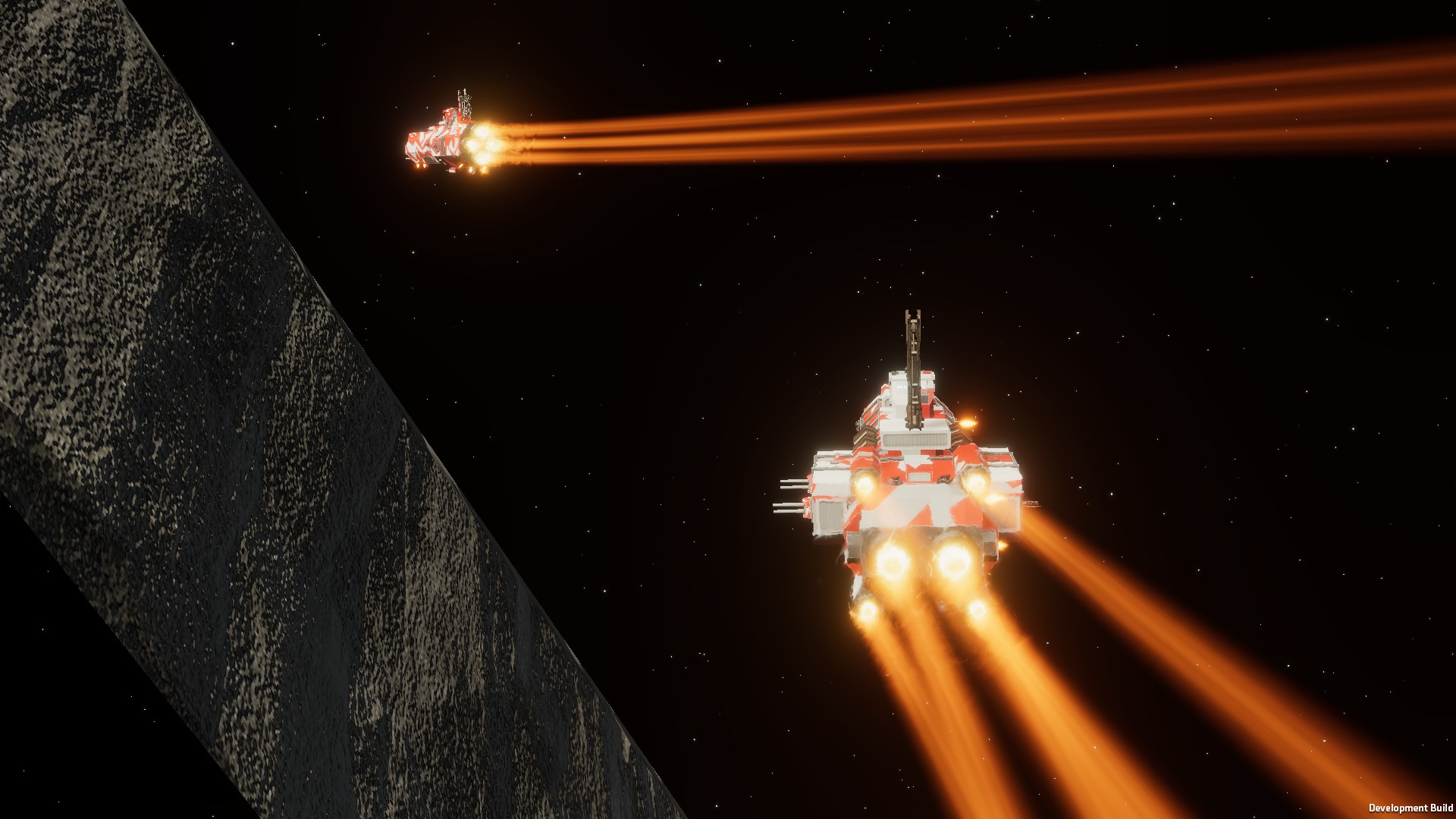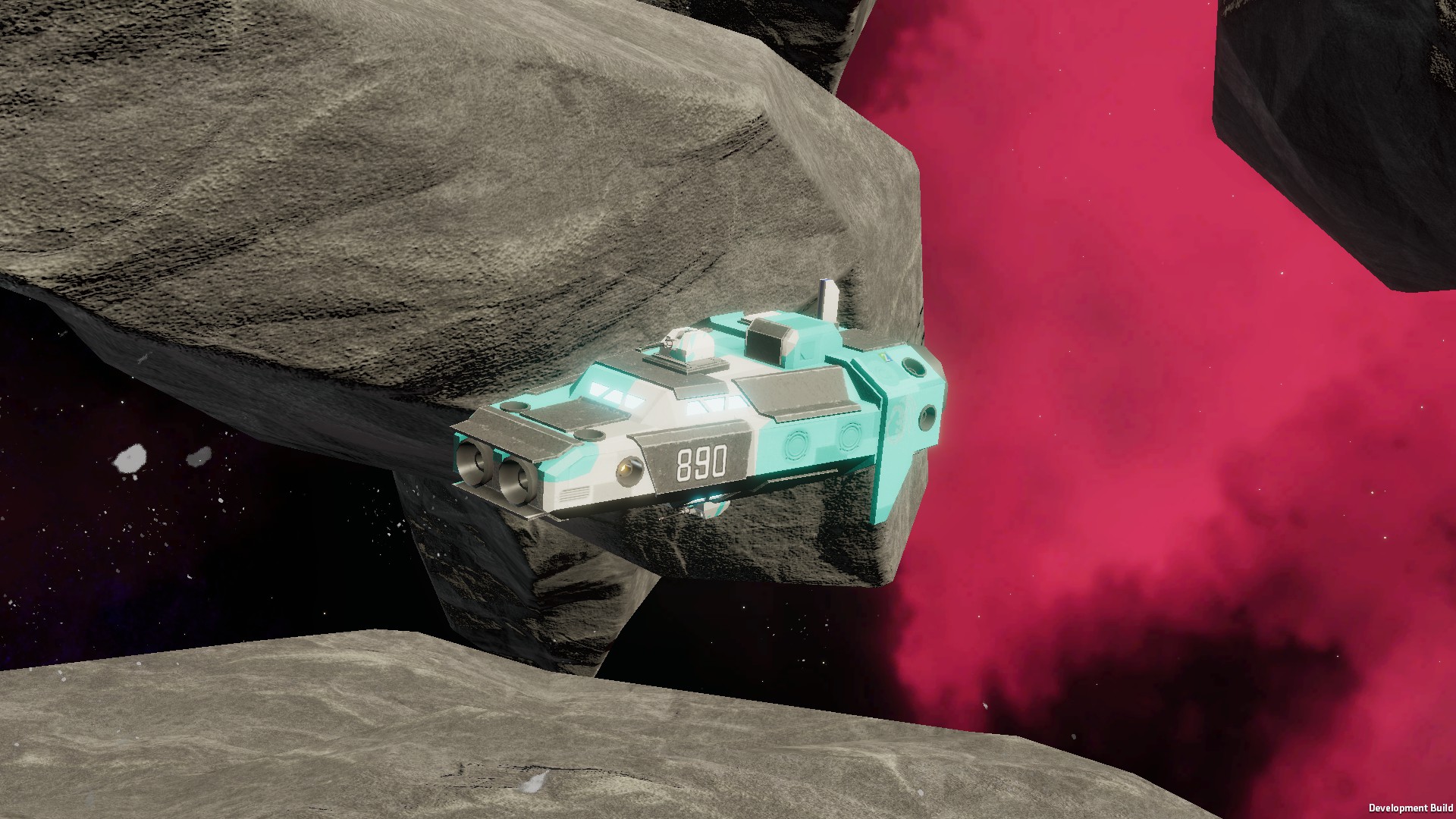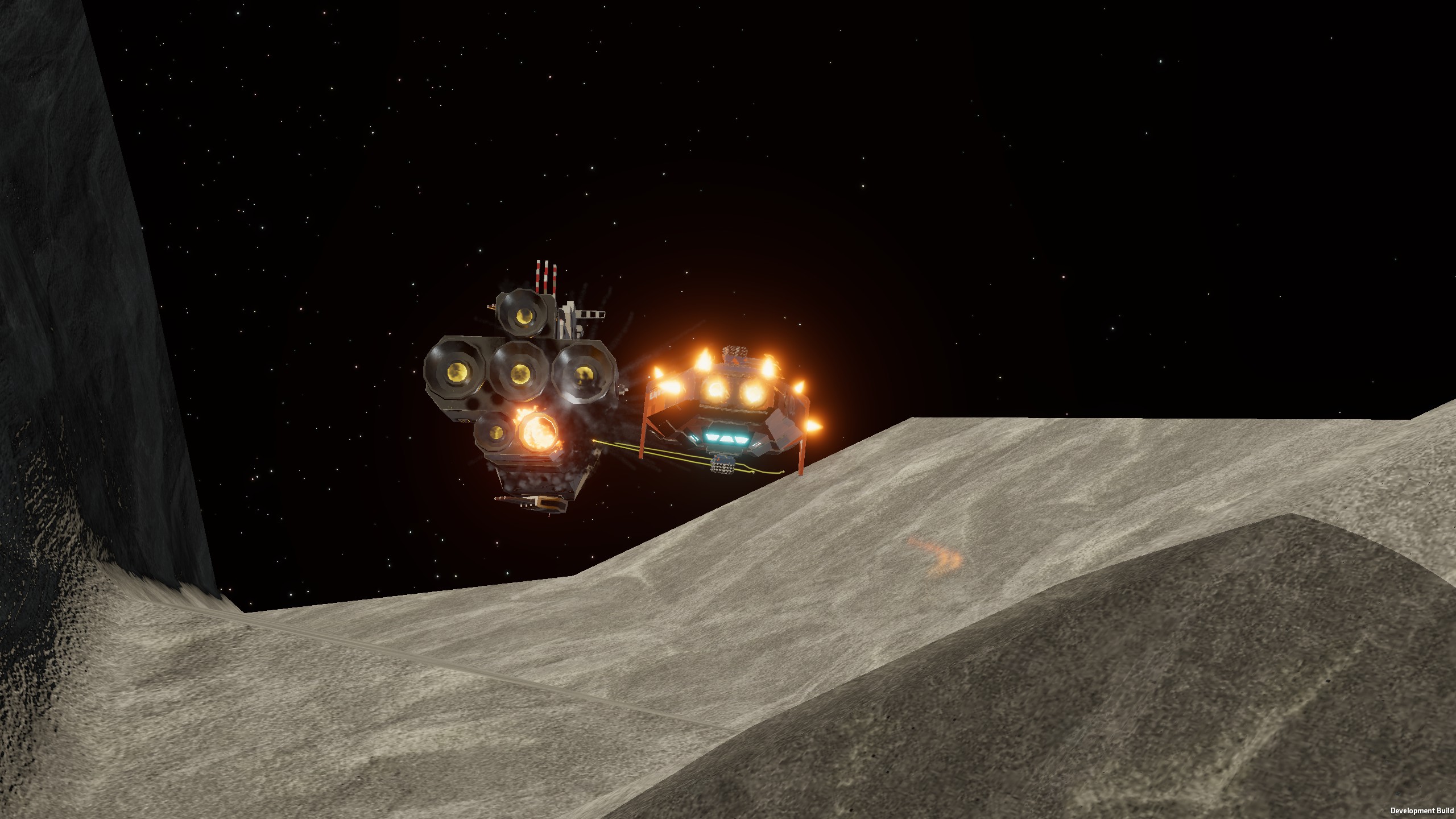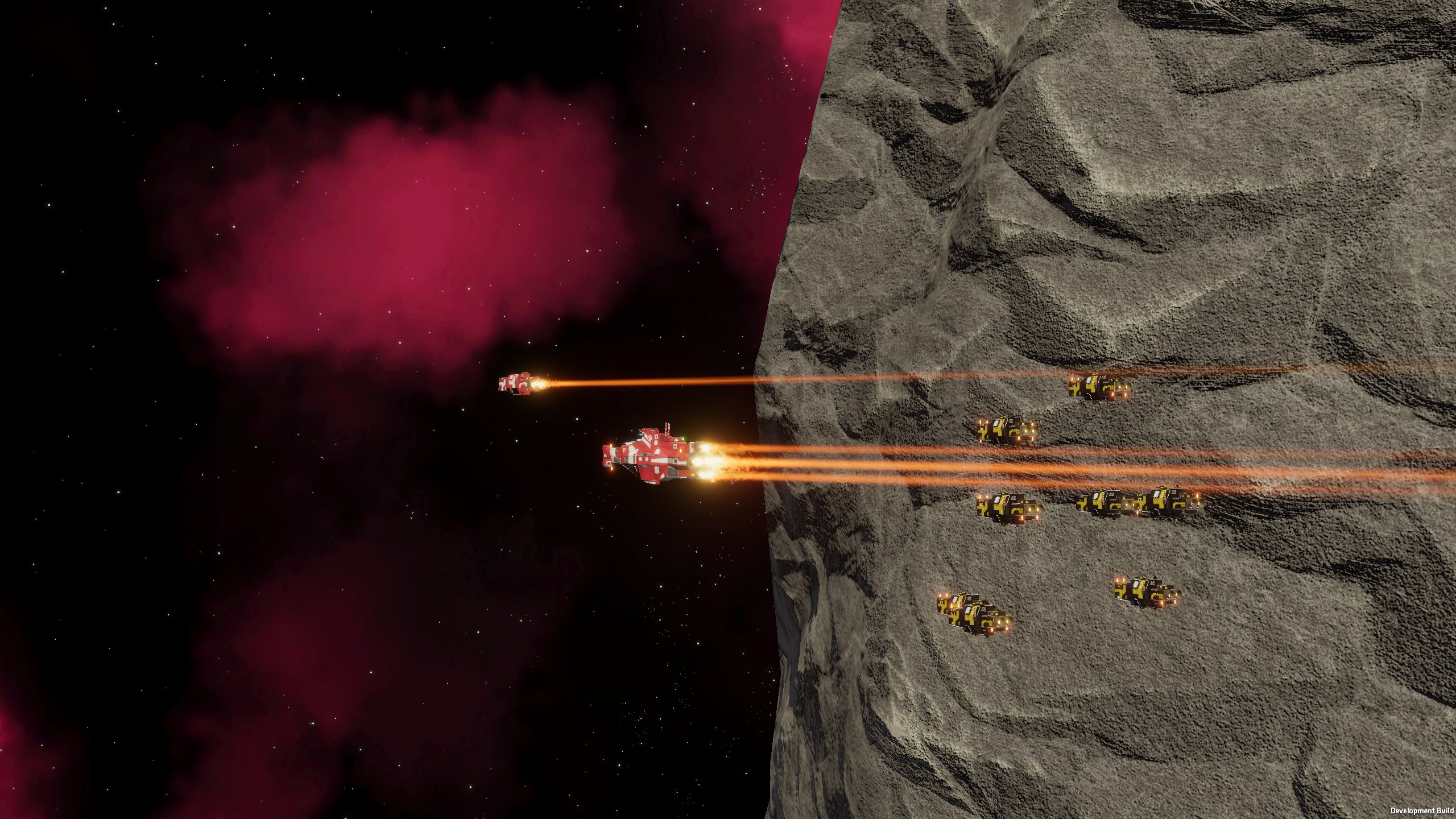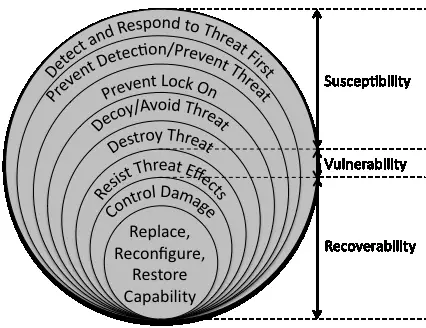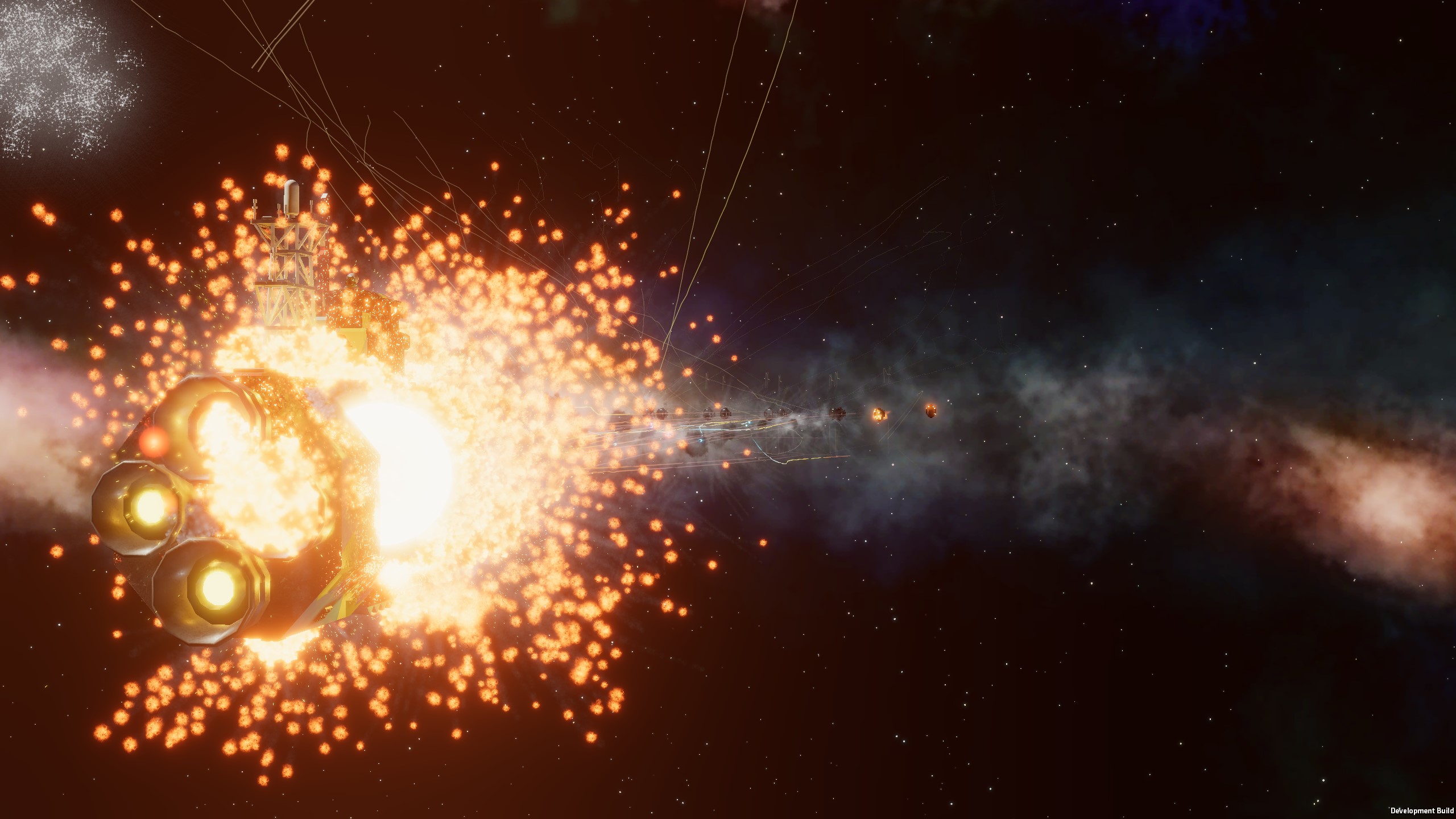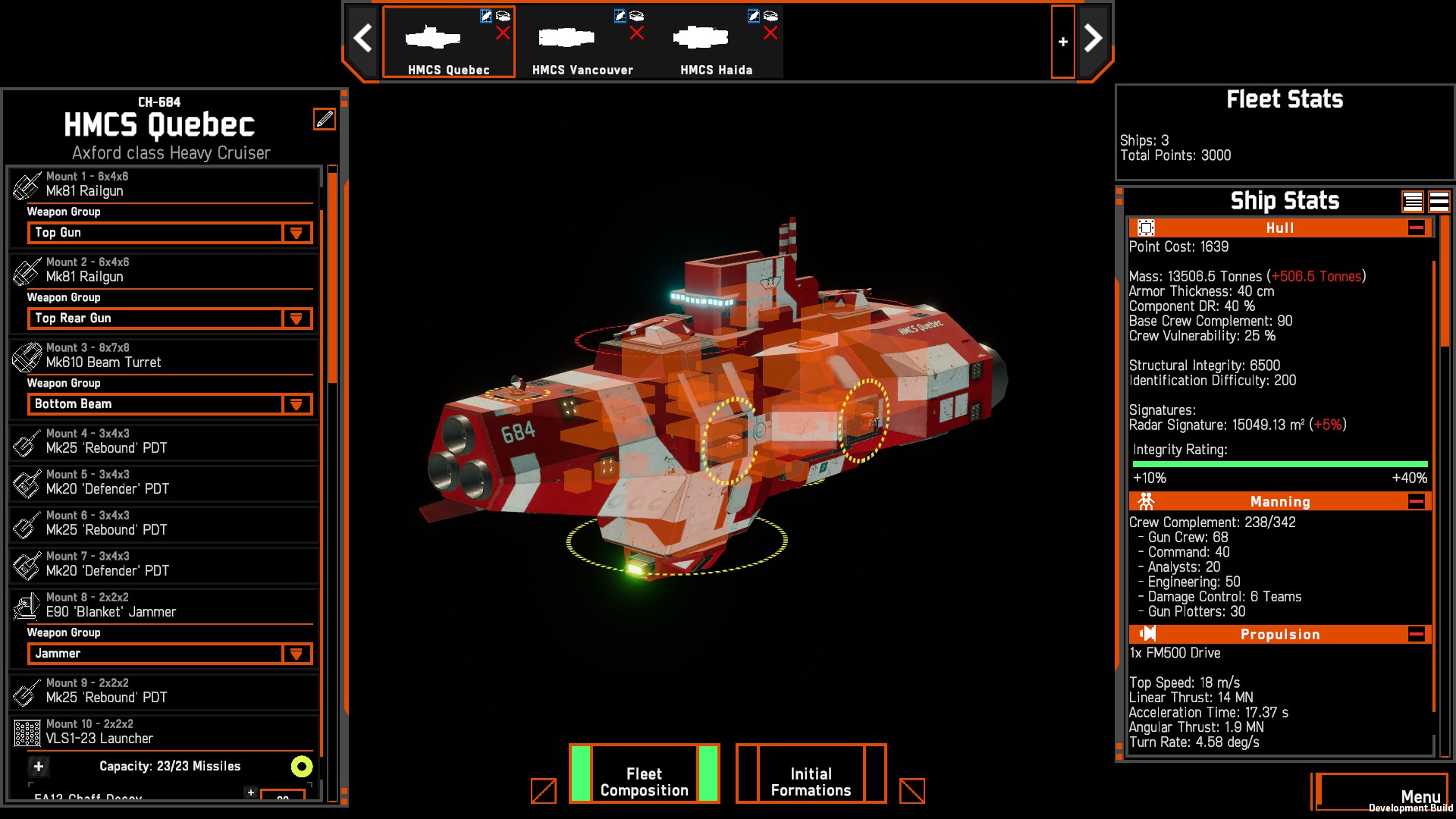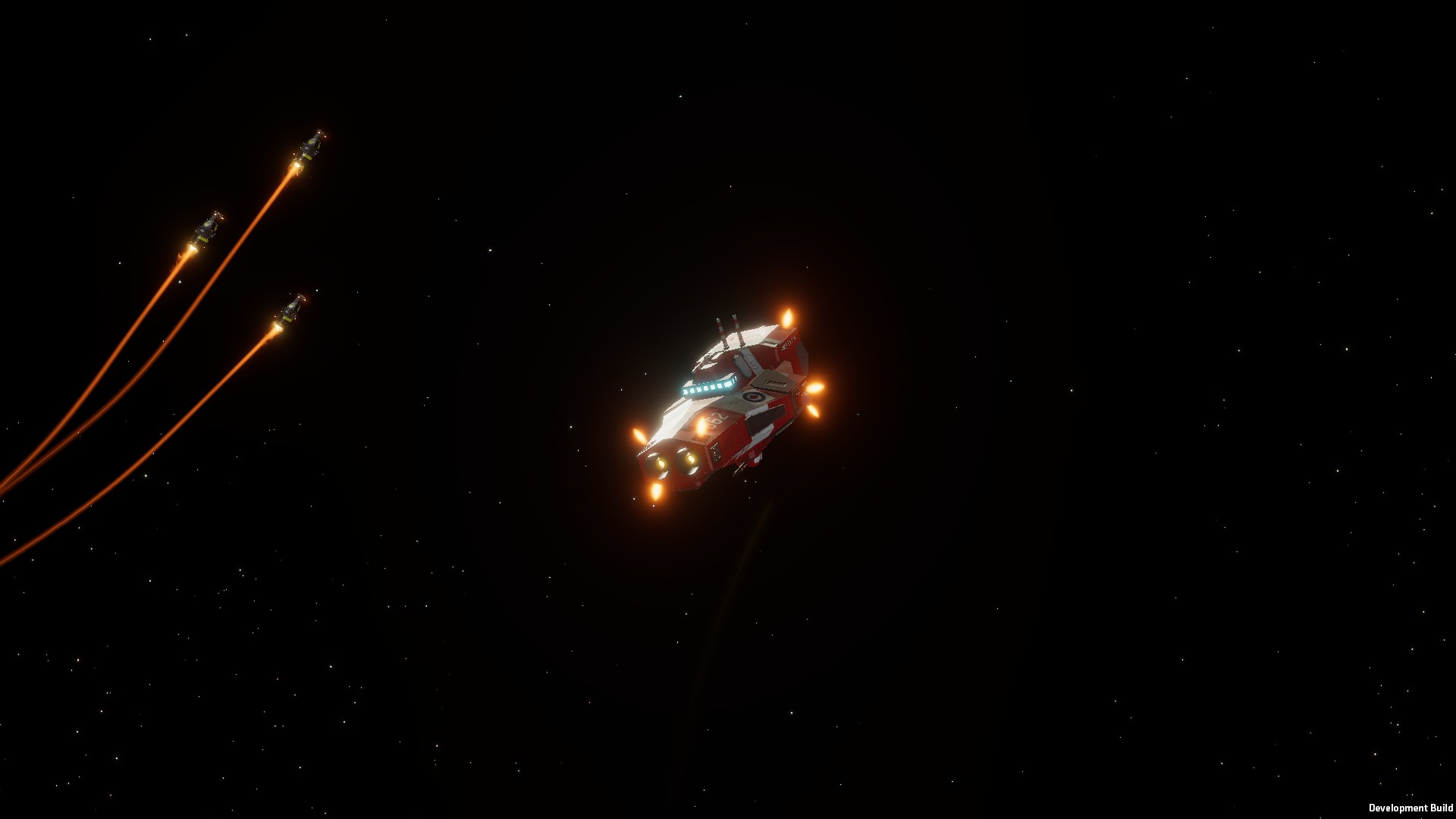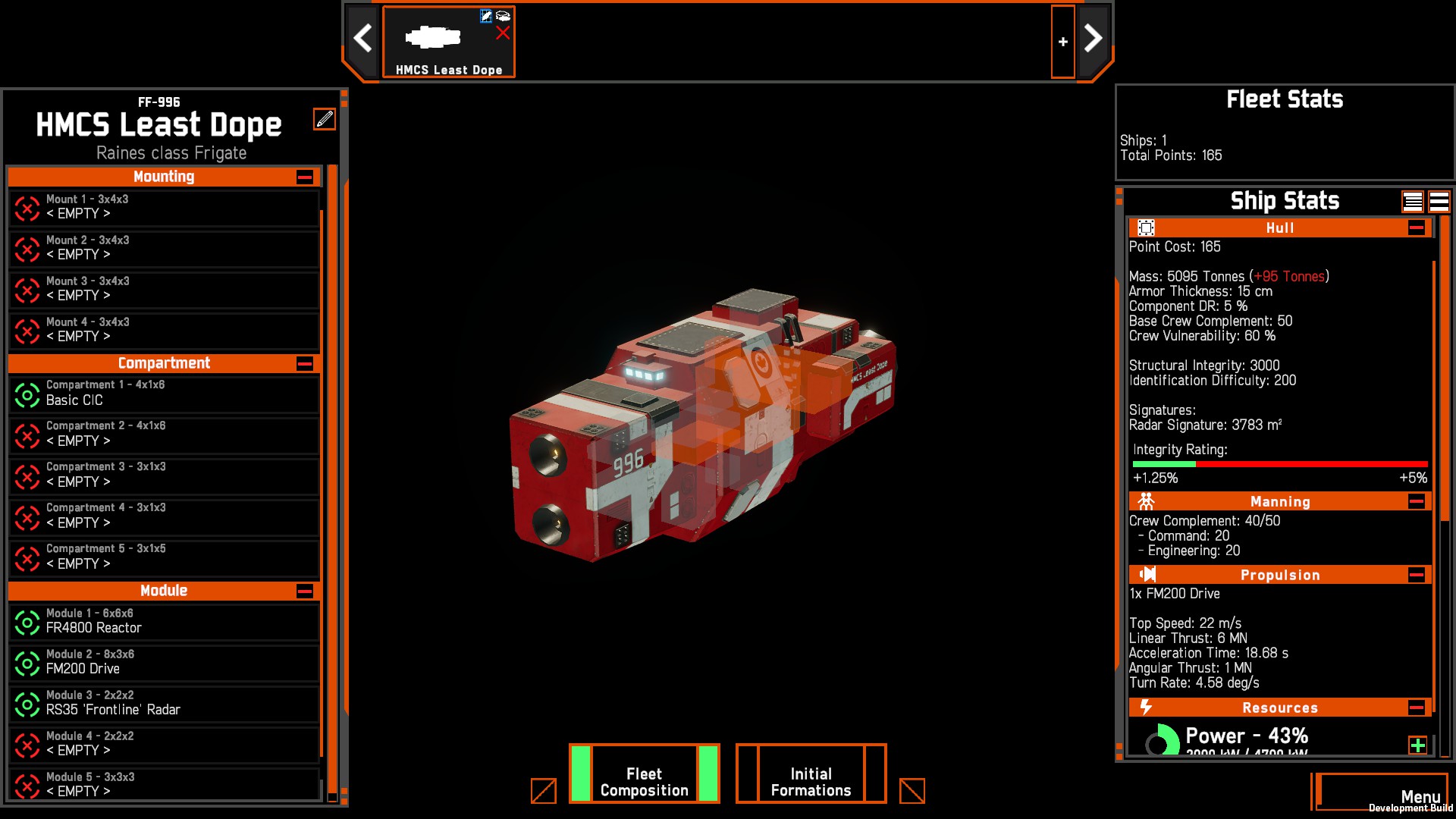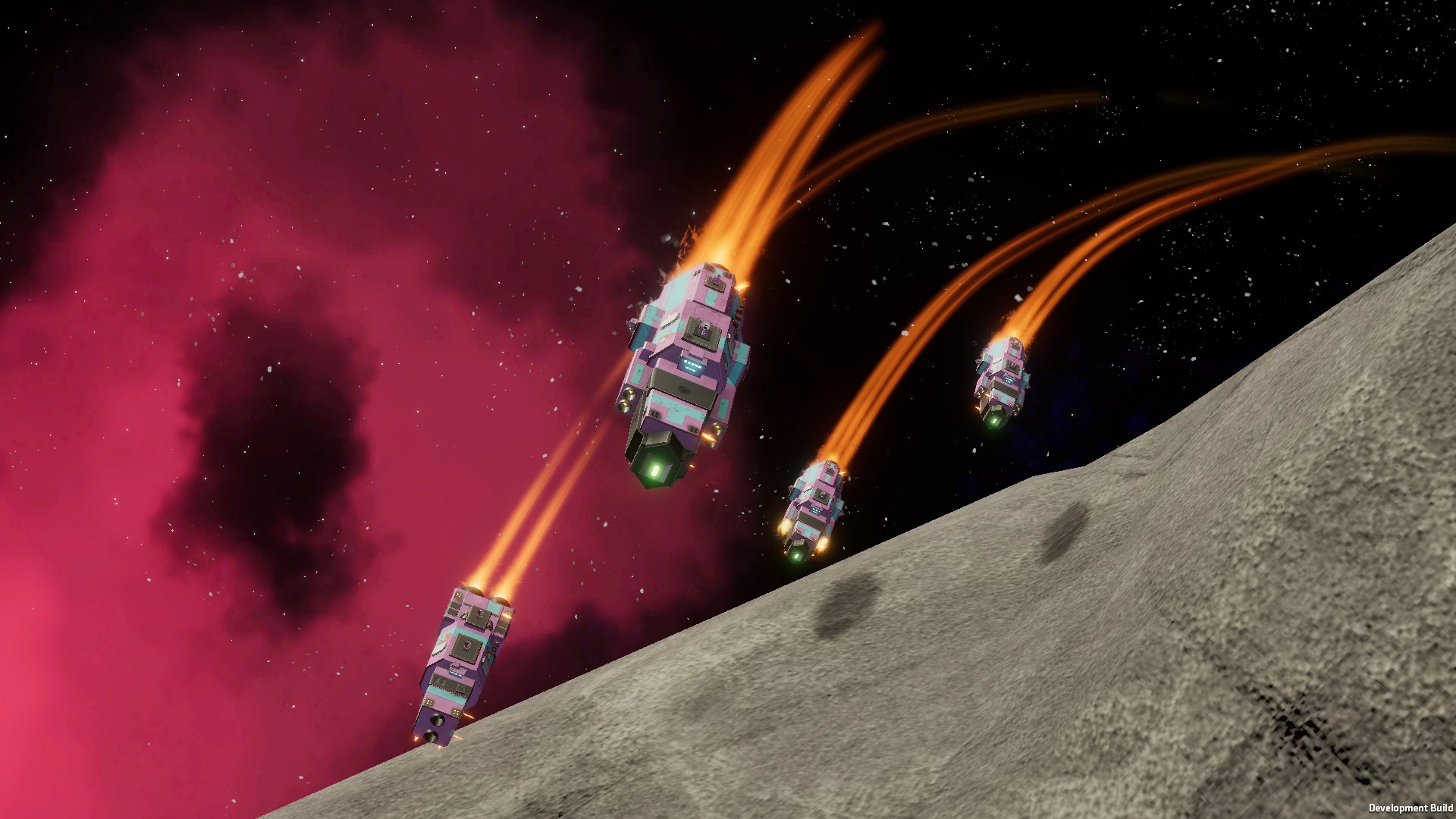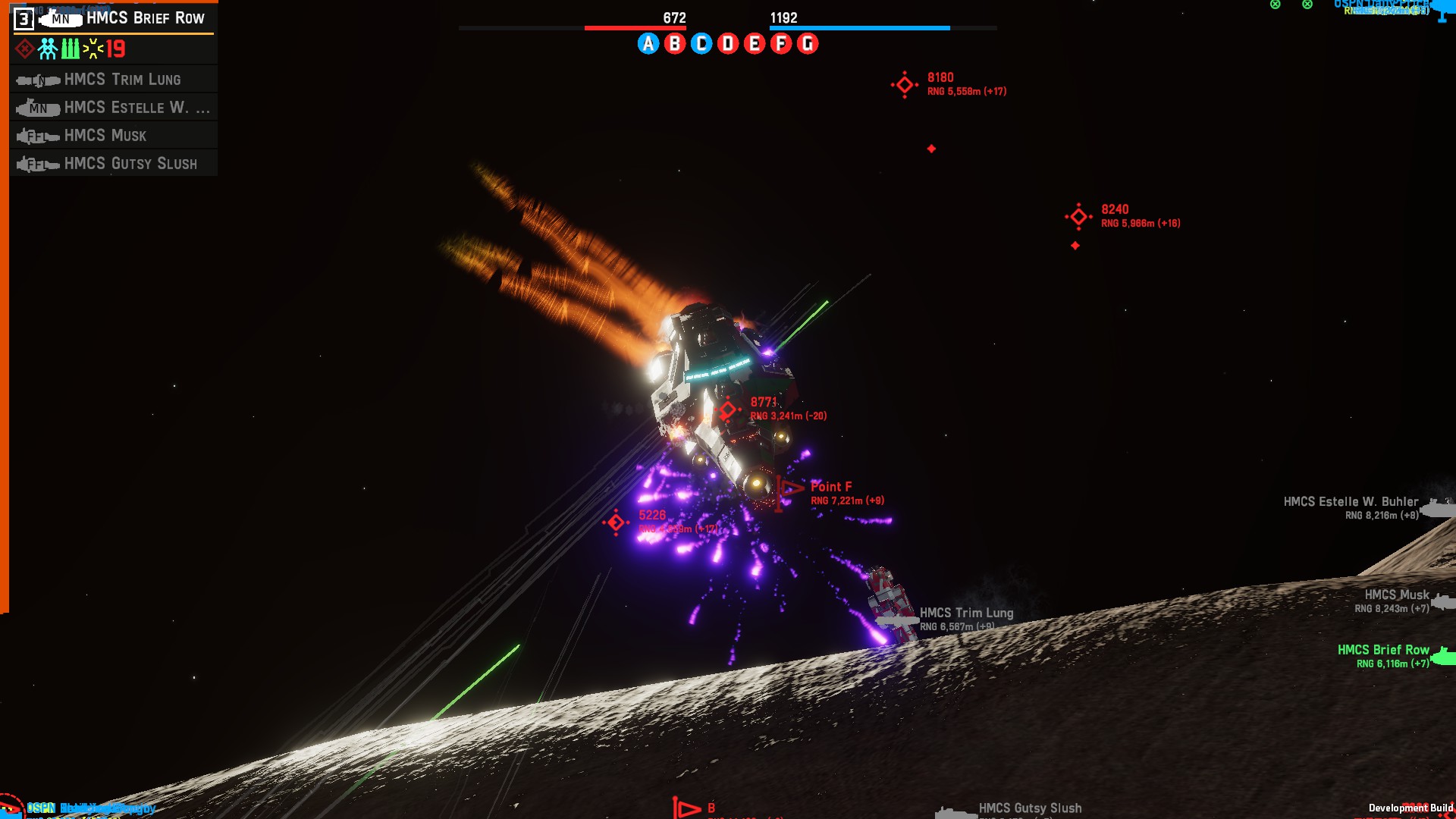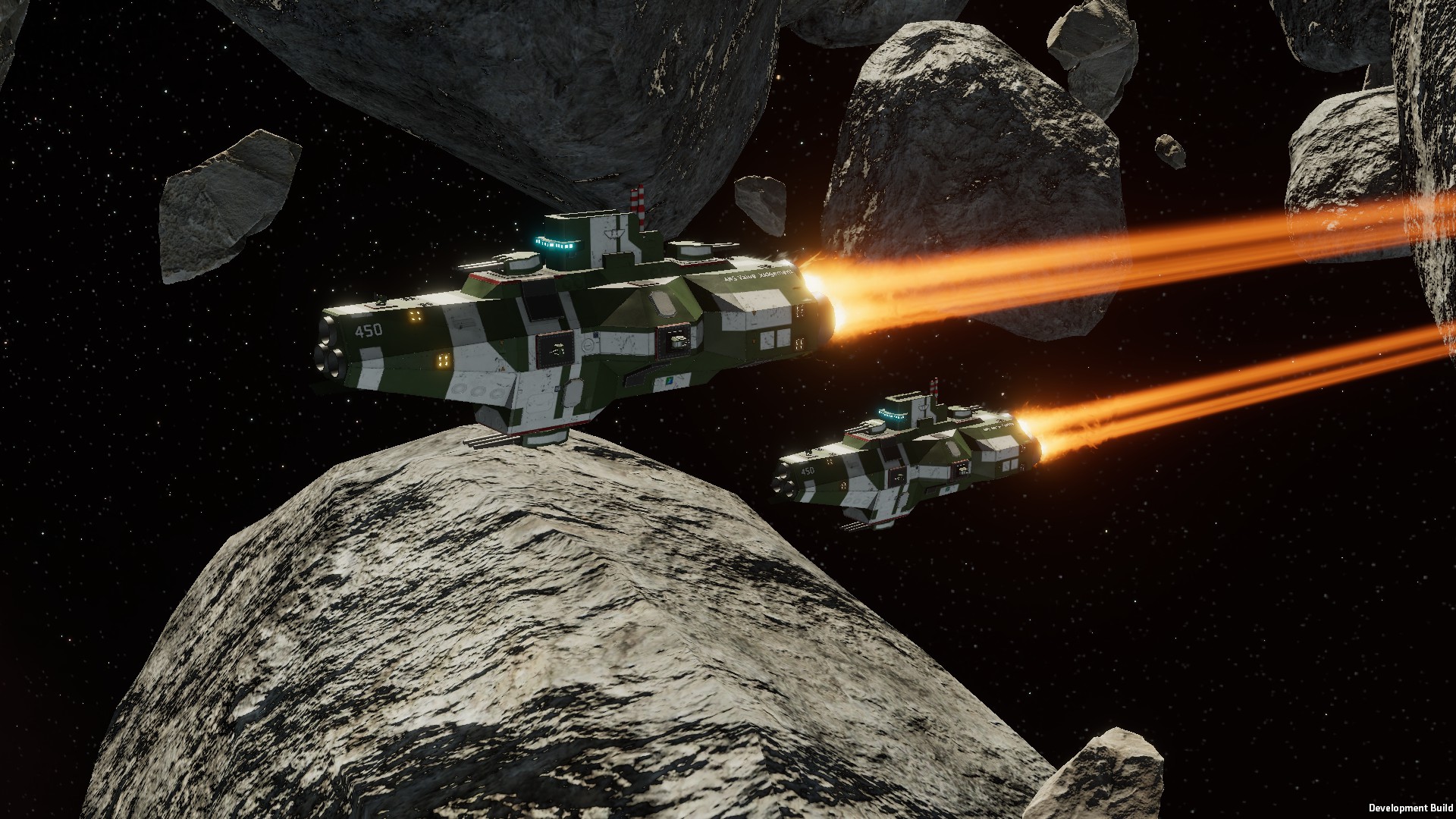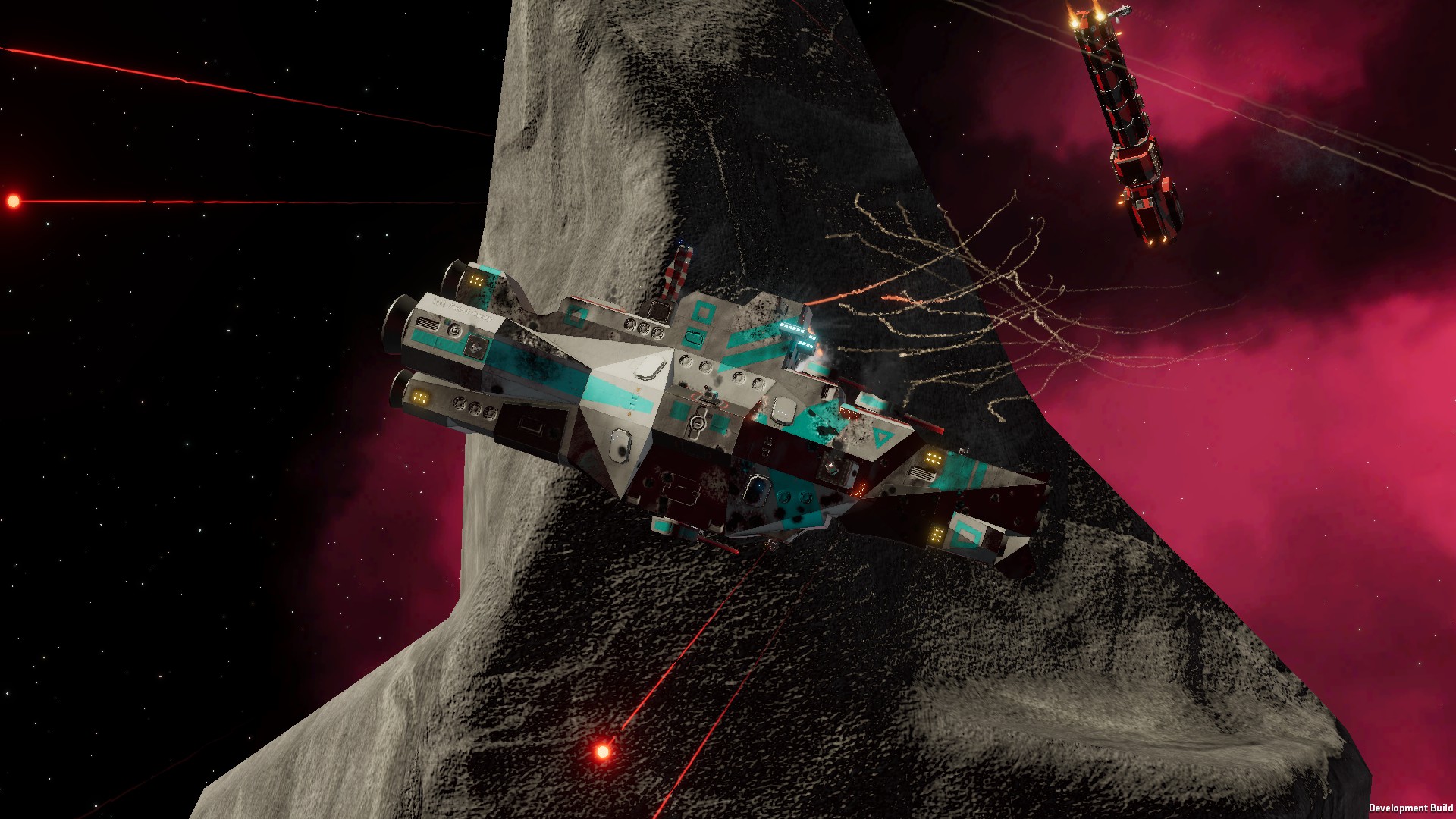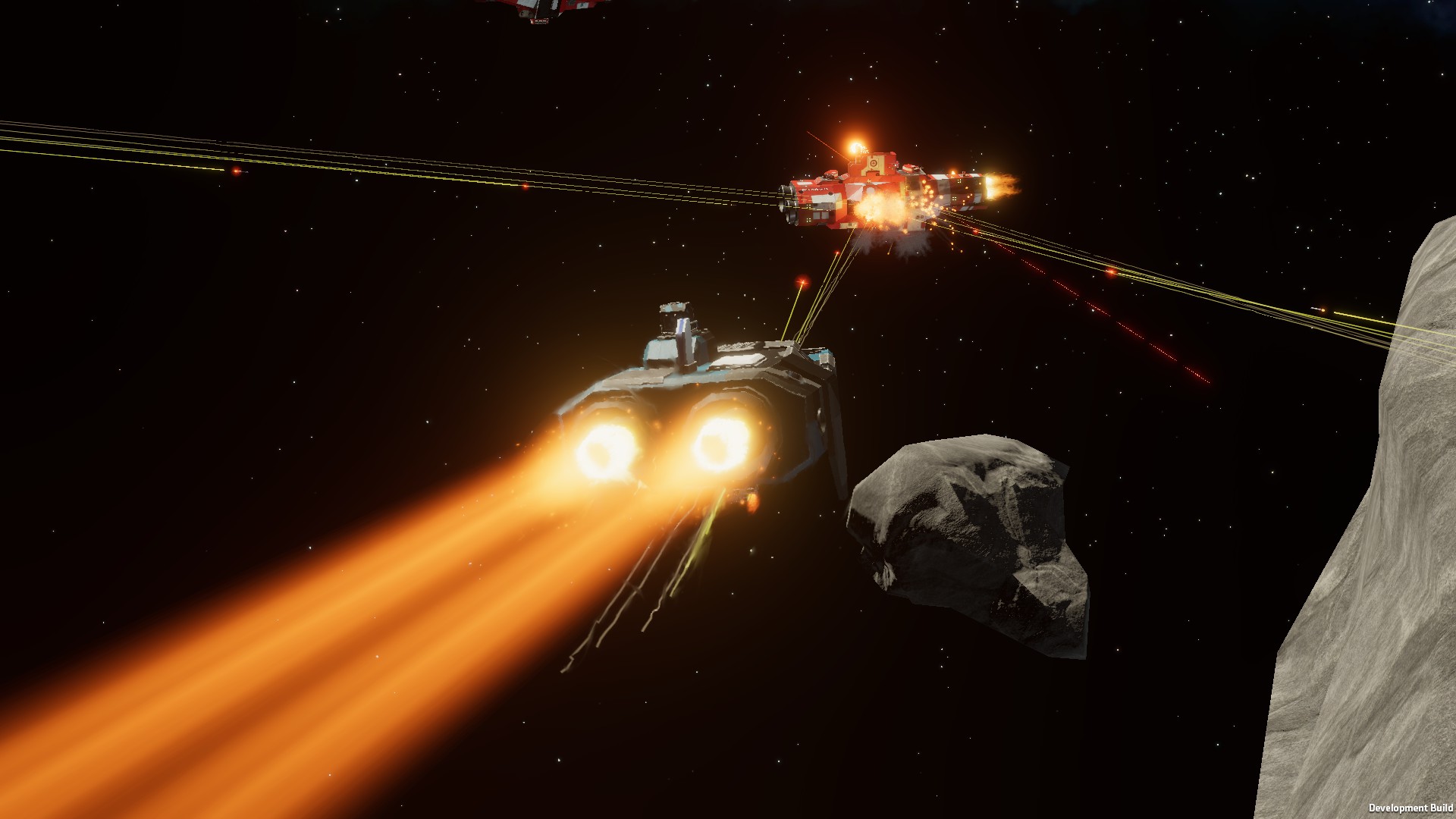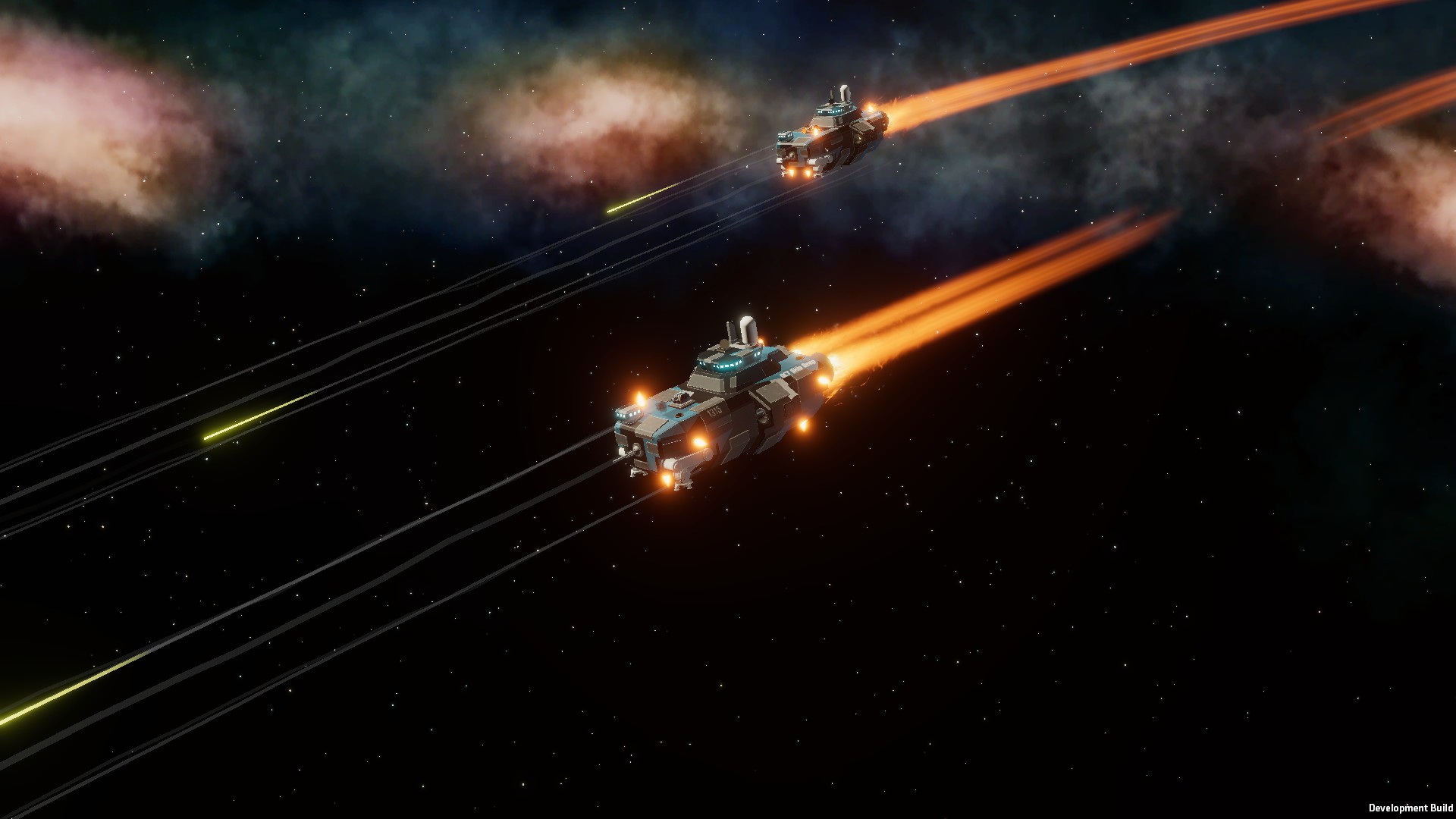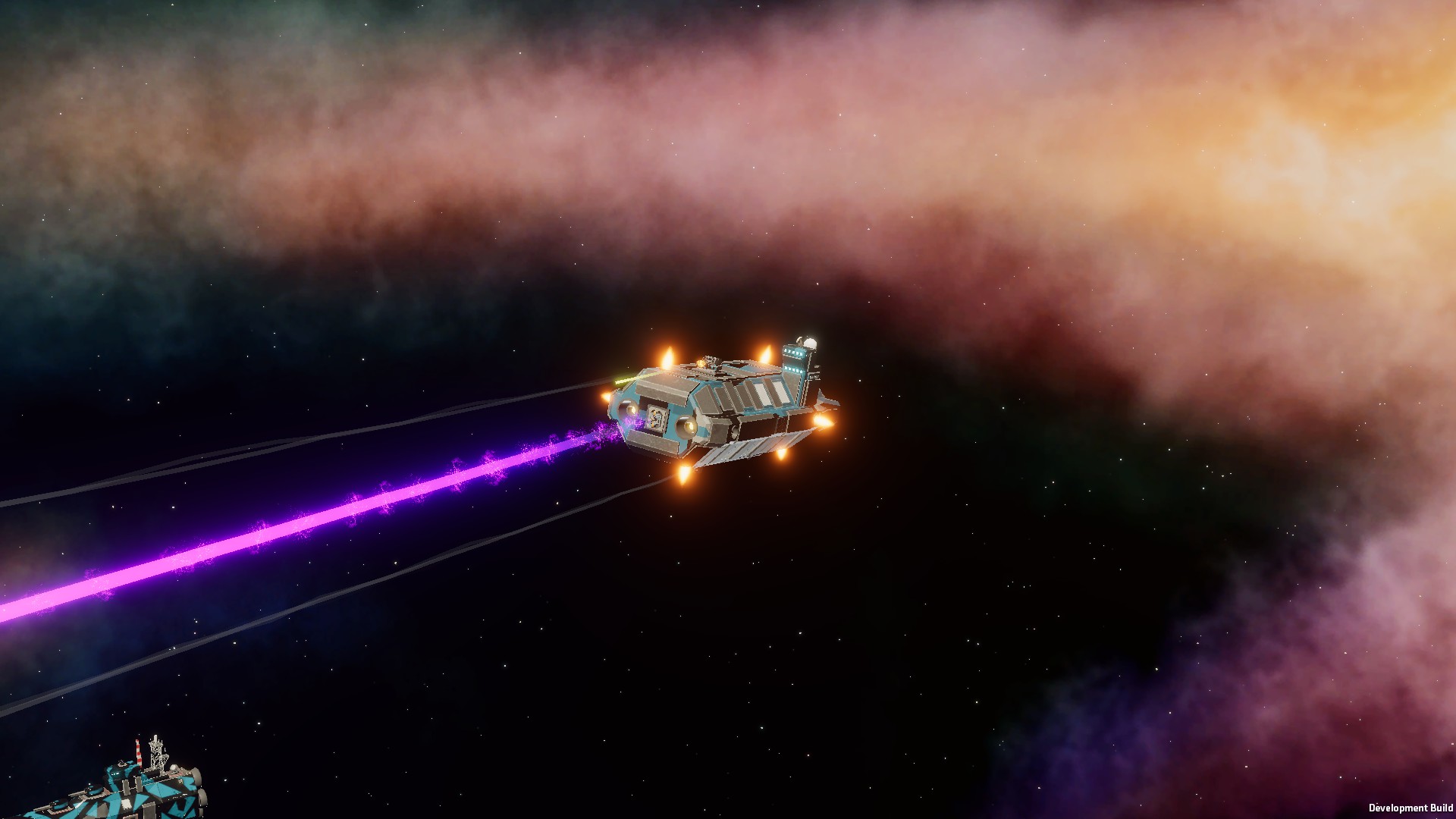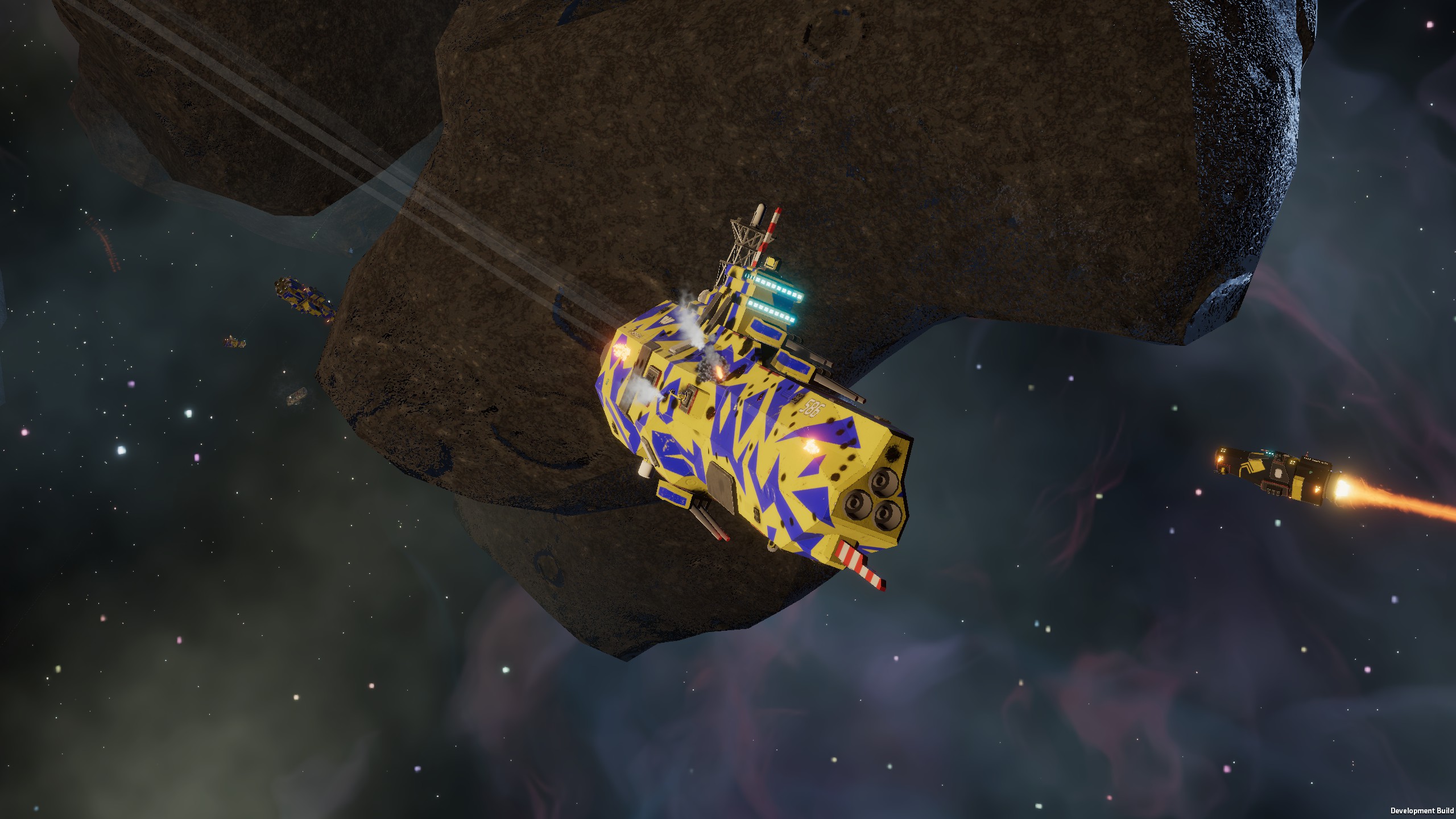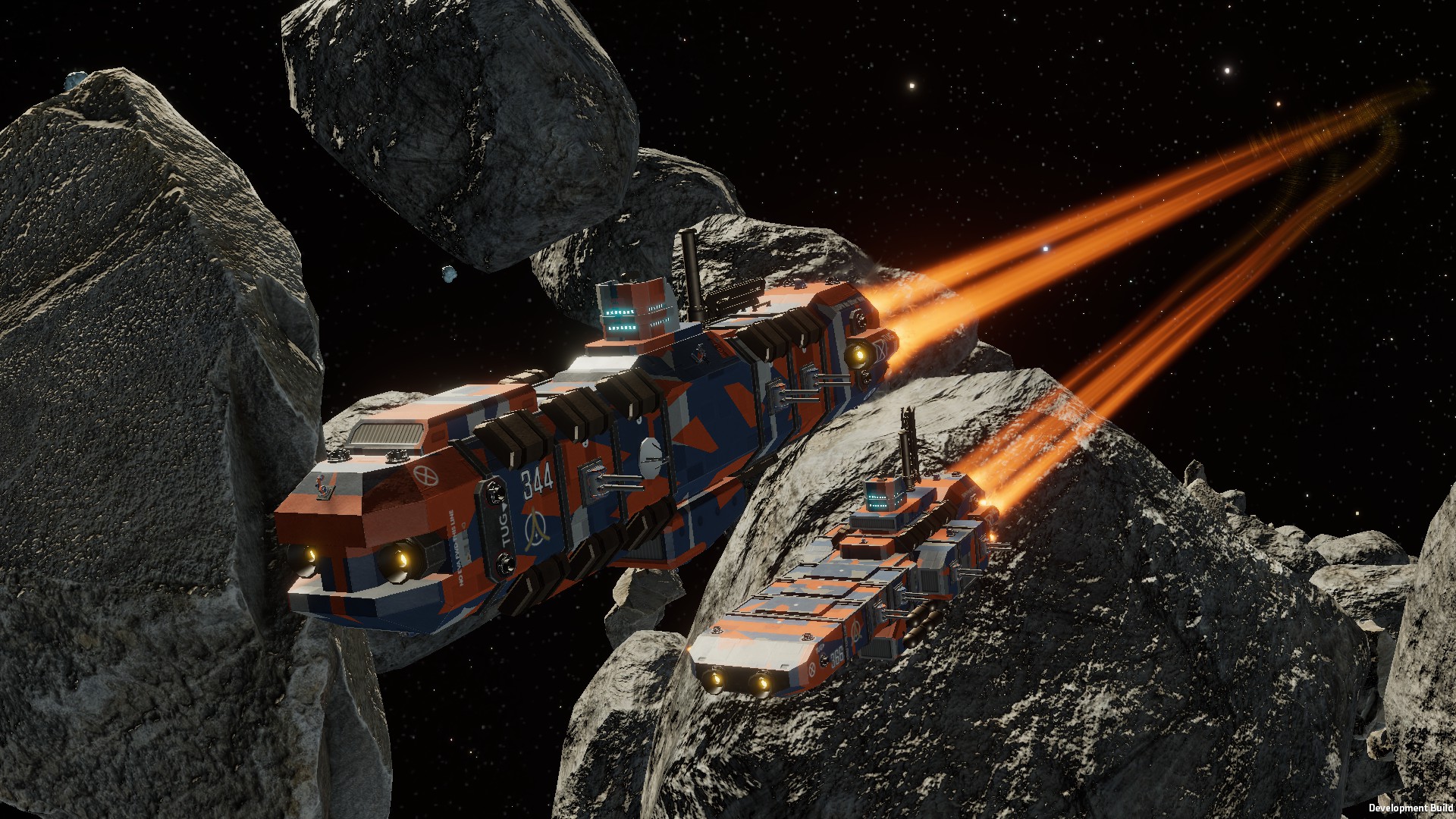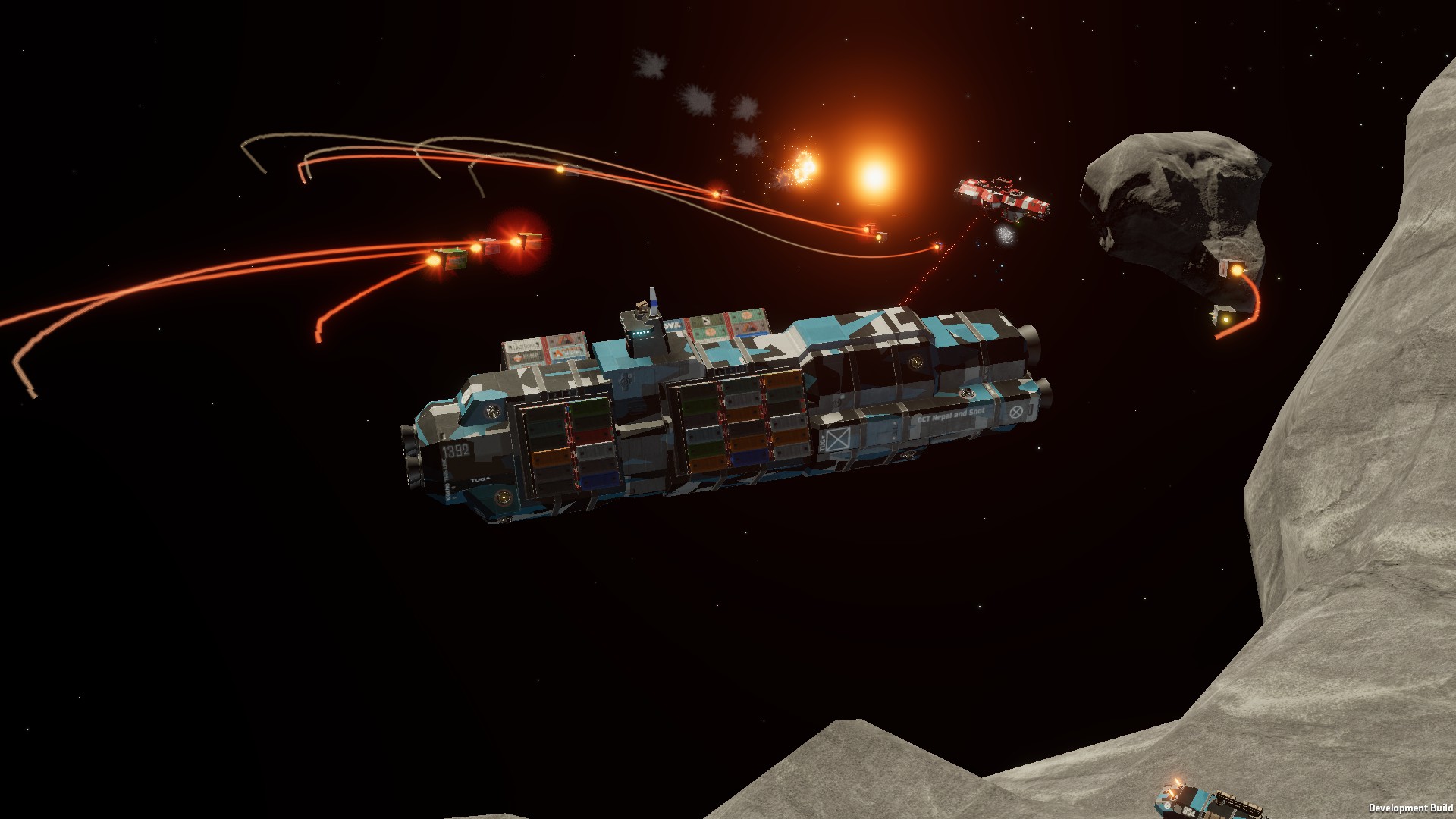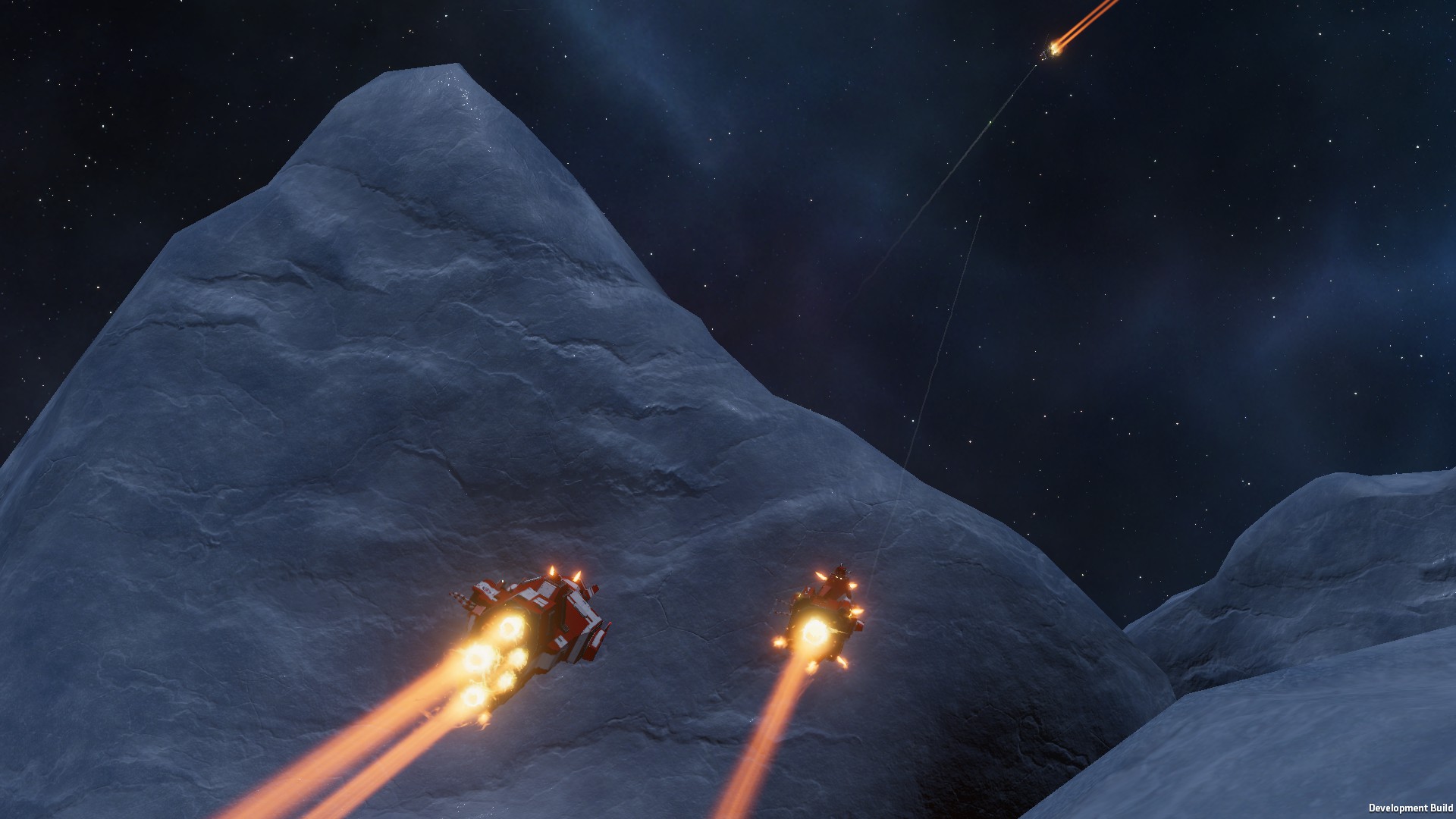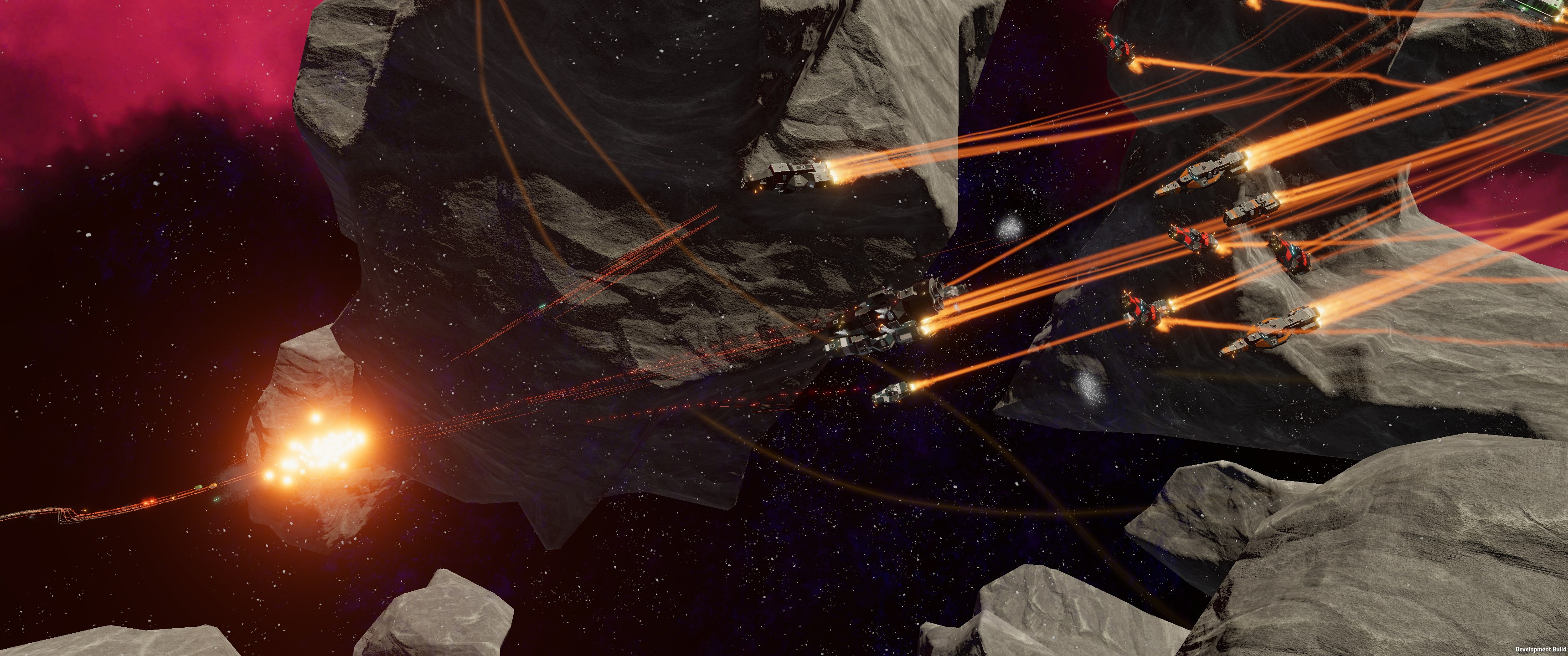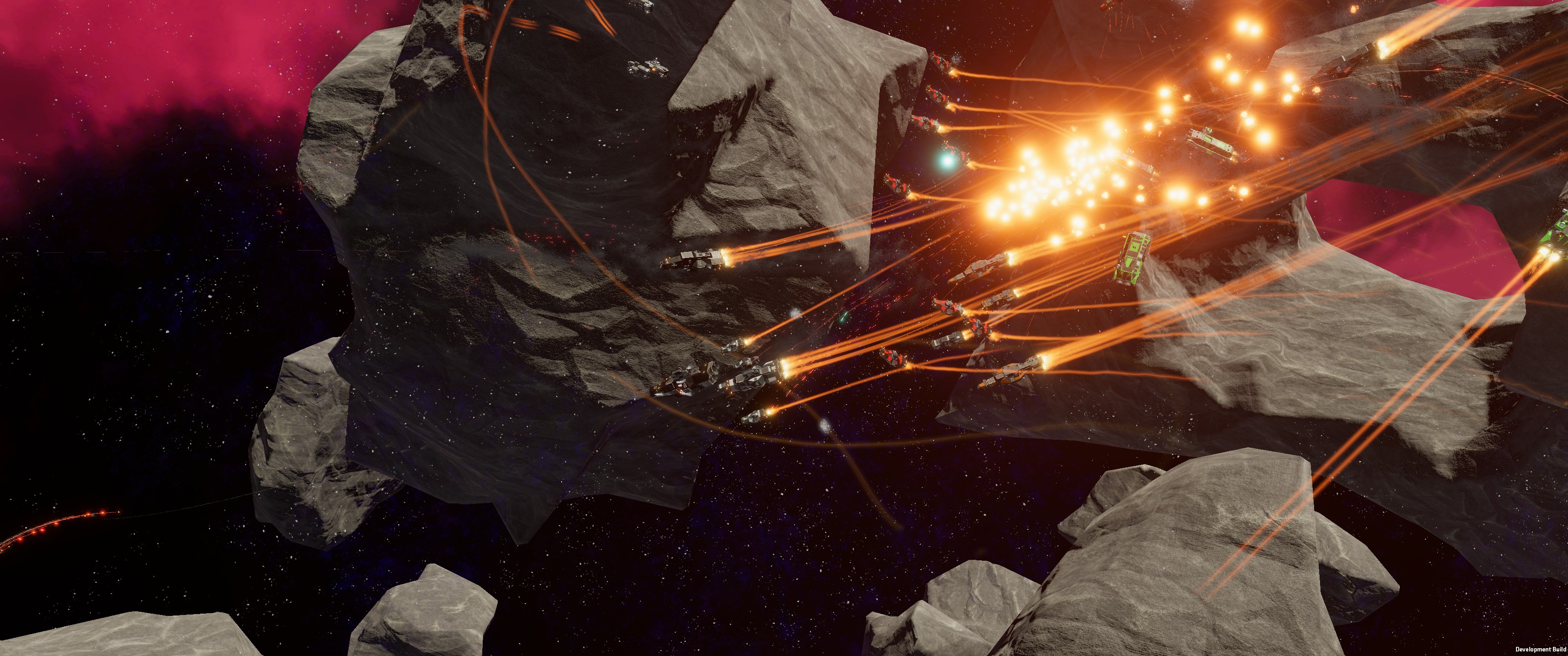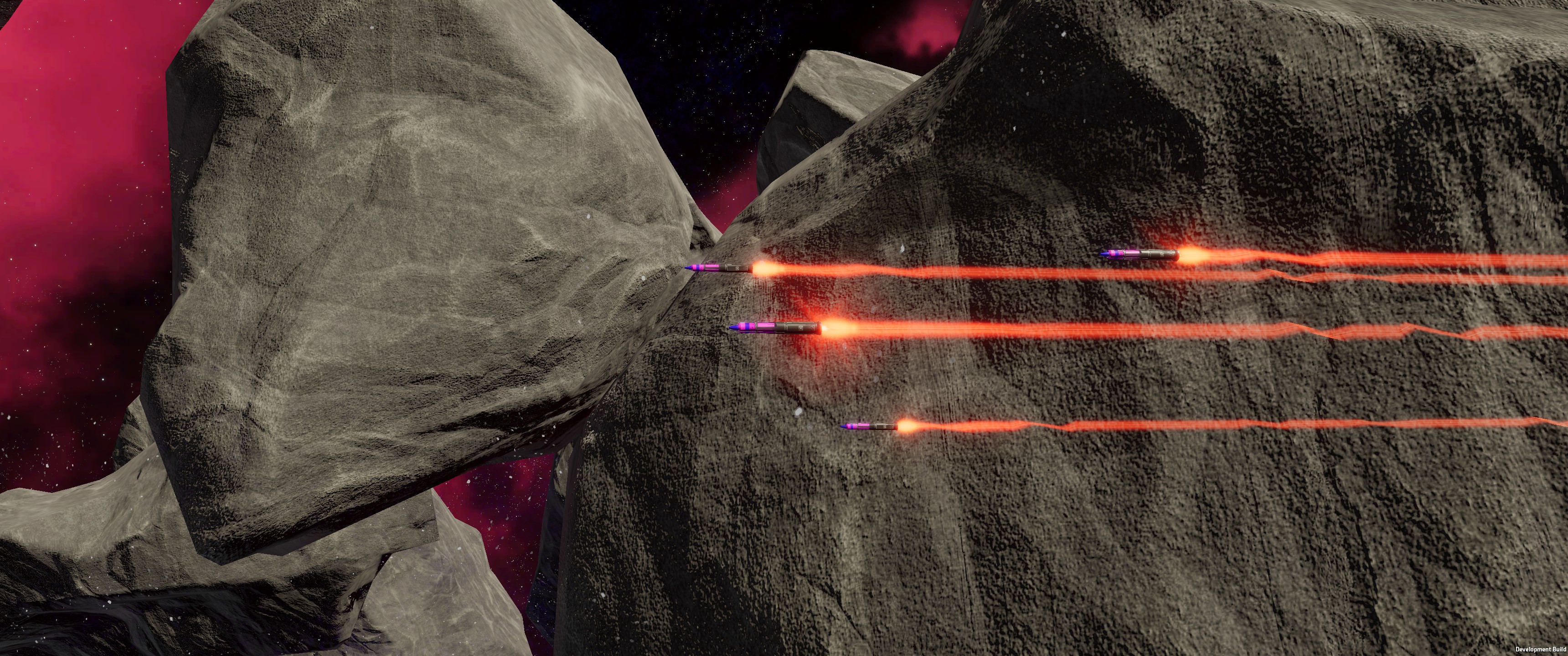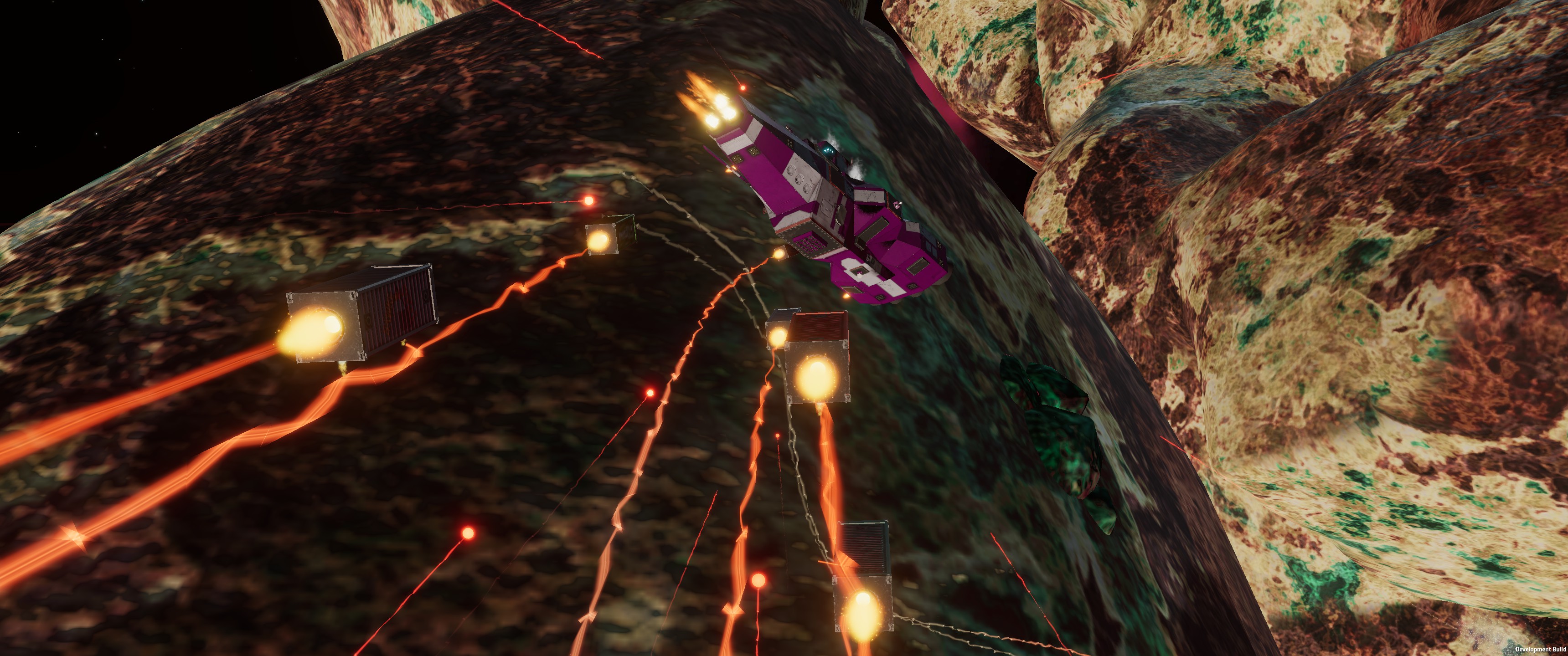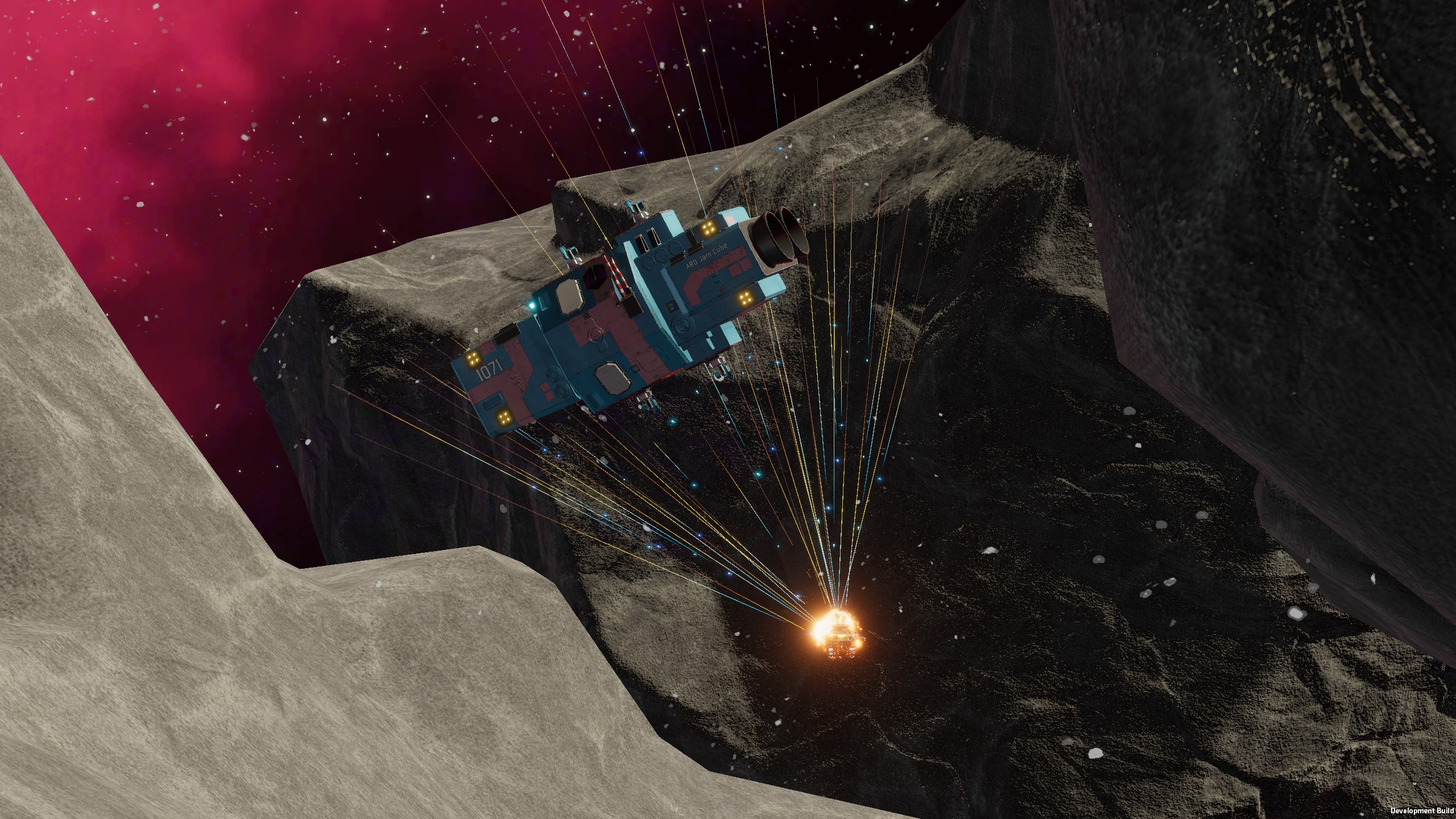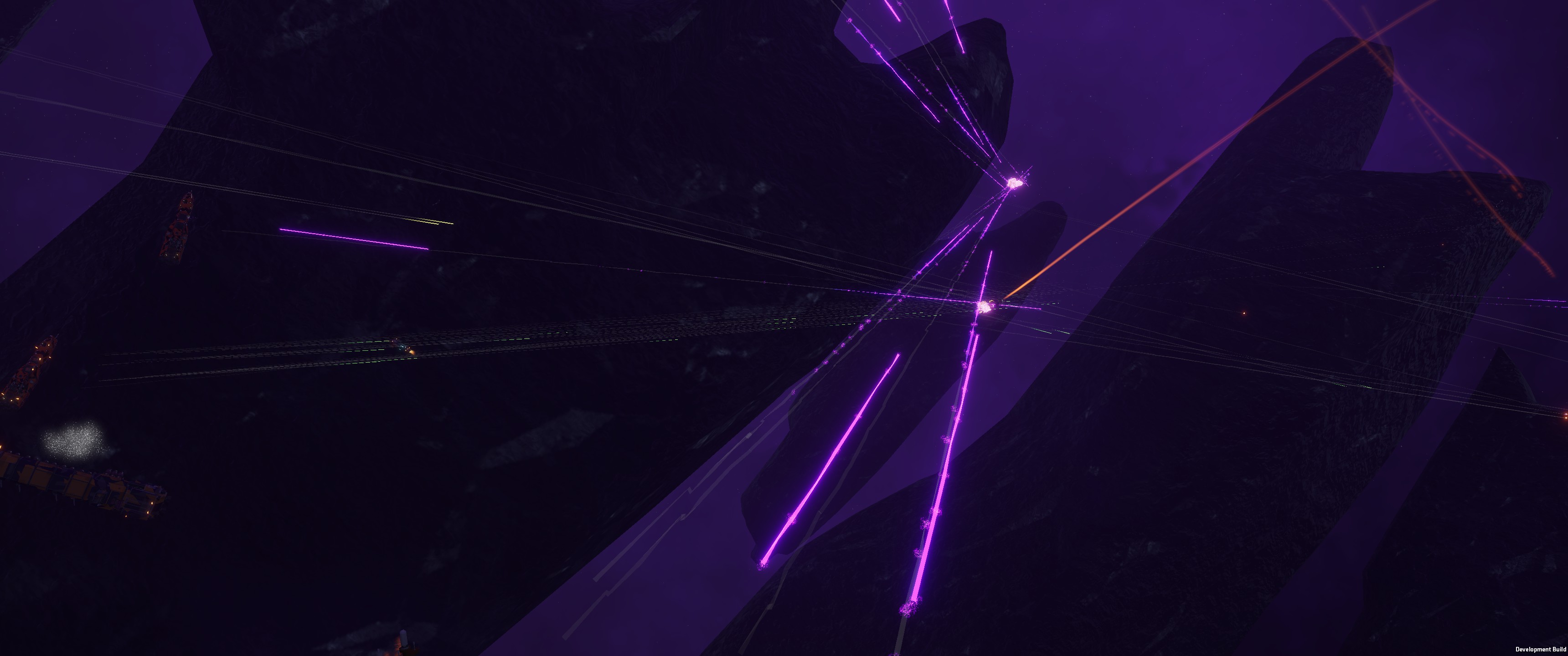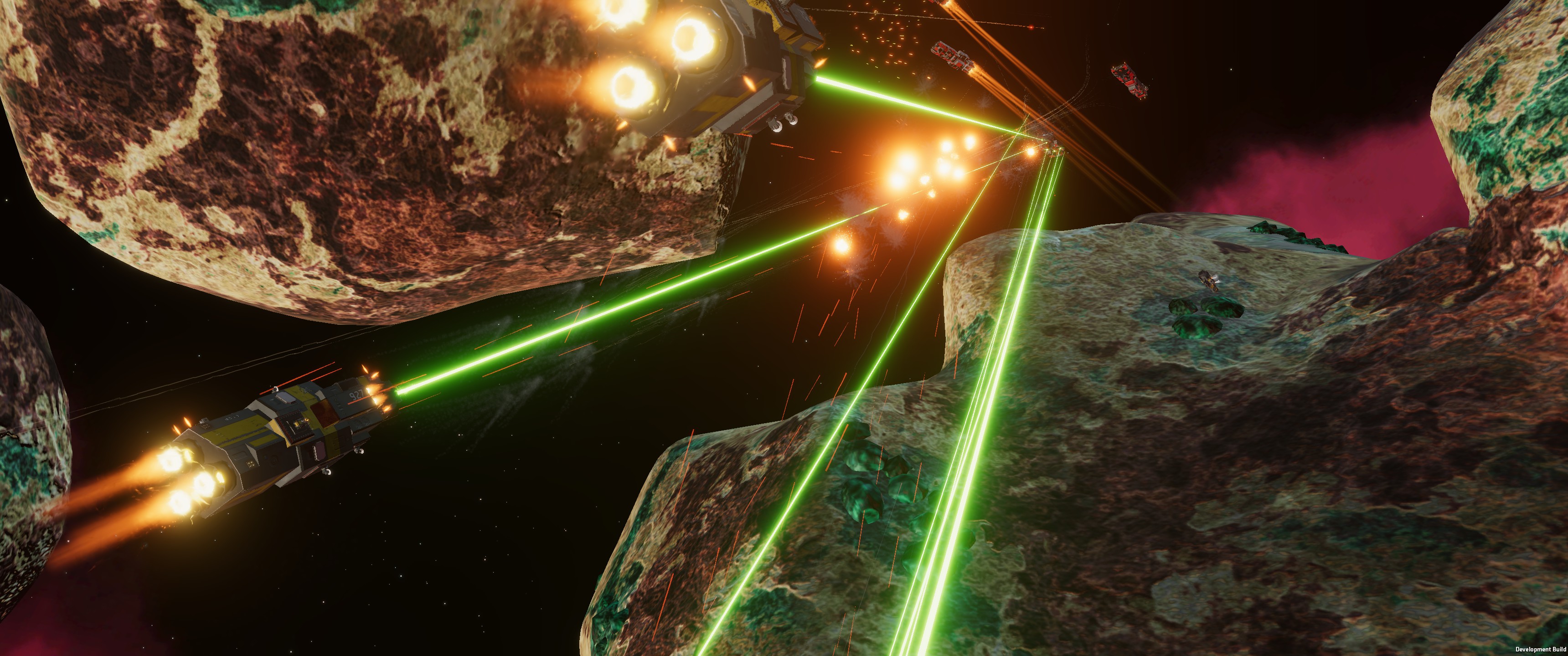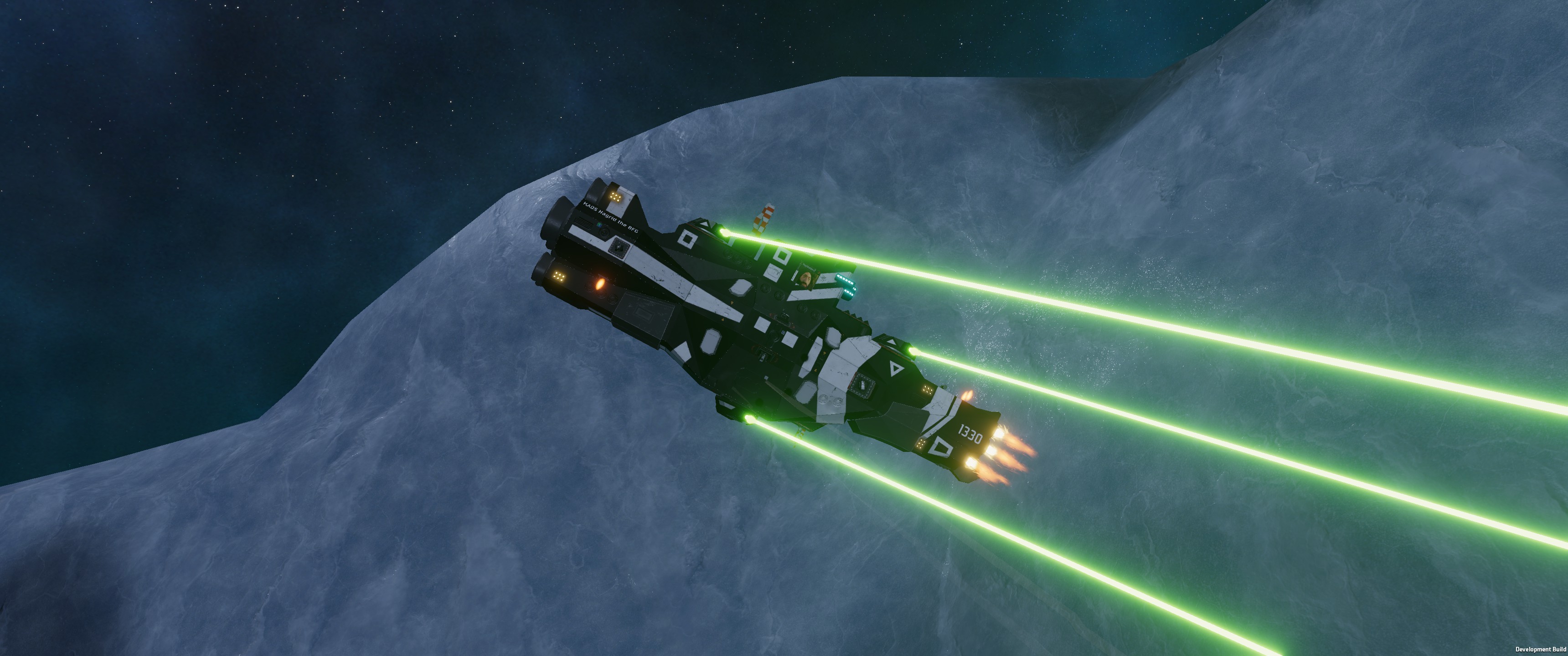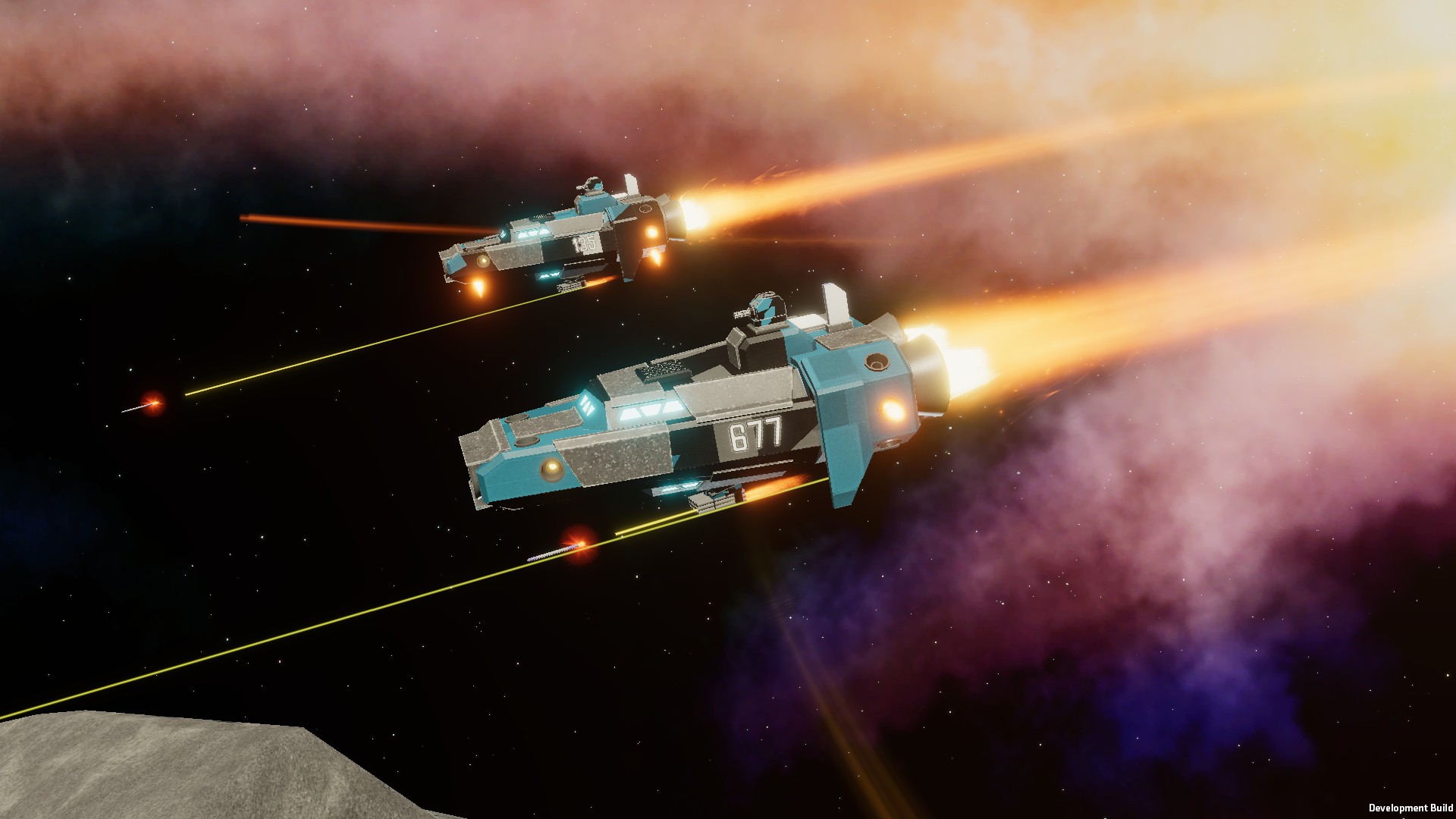This guide, co-authored by myself and various contributors, offers comprehensive insights into constructing your fleet from scratch in Nebulous. It delves deeply into strategy and the decision-making process. It aims to address the following key questions:
- What are the fundamental fleet doctrines in Nebulous, and how can you tailor your fleets to align with these doctrines?
- How can you design a robust and versatile fleet build that can withstand a range of plausible threats?
- What is the impact of the choices you make in the Fleet Editor on the tactical and strategic aspects of the build you’re creating?
In this guide, we will provide you with valuable information and guidance to help you make informed decisions and build an effective fleet in the Nebulous universe.
Fleet Doctrines In Nebulous
(Image Credit: Vren55)
The enduring potency of dakka may be undeniable, but within the realm of Nebulous, fleets adhere to five distinct principles or doctrines. It’s important to note that not every fleet must encompass all of these principles. In fact, attempting to do so often results in a significant strain on a 3000-point budget. Instead, fleets are typically tailored to embody a select few of these doctrines.
This section serves a dual purpose: to elucidate the nature of these doctrines and to emphasize the components within a fleet that align with each respective doctrine. It’s worth mentioning that there is often a degree of overlap among these doctrines, adding complexity to fleet design in Nebulous.
Information Acquisition
(Image Credit: Vren55)
In Nebulous fleet strategy, the concept of Information Acquisition, also referred to as map awareness and sensor coverage, is a pivotal principle. It involves the capacity to gather vital information for your fleet and team. This information encompasses various aspects:
- General Ship Tracks: These are obtained through radar and electronic location devices like Spyglass and Early Warning Radar, as well as Pinards. While these tracks may lack the precision required for accurate targeting, they provide crucial positional information.
- Accurate Ship Tracks: Achieved through more precise radars, these tracks are precise enough to facilitate targeting and are acquired via Bullseye locks, Long Range Tracking Radar, and can be further refined through the use of Track Correlators.
- Map Awareness: This aspect is gained through radar and a network of scouts, typically shuttles or sprinters, or concealed scouts like Spyglass frigates and ships equipped with Prowler drives. They cover different sections of the map from diverse angles, enhancing your understanding of the battlefield.
- Intelligence and Identification: Equipping a ship with an intelligence center enables the acquisition of intelligence and identification of both enemy targets and non-targets. This is crucial for informed decision-making.
- Electronic Counter-Countermeasures: To counteract enemy jamming and Electronic Warfare, fleets employ Electronic Counter-Countermeasures. This involves technologies such as burnthrough, dedicated fire control radars like Bullseyes on ANS, Floodlights, Long Range Tracking Radars, and offset scouts, such as ships equipped with R400 on OSP.
Information Denial
(Image Credit: Regional Math Blob)
Information Denial, in the context of Nebulous fleet strategy, is an artful approach aimed at leaving your adversaries in a state of confusion, rendering them deaf to vital information, and disoriented in their decision-making. The primary objectives of information denial are to deprive your opponents of useful insights into your fleet and your team’s fleet or to inundate them with contradictory and bewildering data. This strategic principle encompasses several methods:
- Targeting Enemy Scouts and Intelligence Vessels: Specializing your warships to eliminate enemy scouts and intelligence gathering vessels is a key tactic. This can involve equipping your ships with Size 1 Ballestra-type offensive missiles for use against Shuttles or Corvettes, launching long-range missile or rail/mass driver strikes against ships carrying Early Warning Radar, and deploying OSPN rocket Shuttles to ambush and seek out ANS Sprinters.
- Employing Electronic Warfare (EWAR) and Electronic Countermeasures (ECM): This involves the use of Blanket and Bellbird jammers to prevent your warships from being spotted or locked onto by enemy sensors. Additionally, the ANS Hangup jammer disrupts enemy ship communication and track sharing, although its effectiveness can vary.
- Managing Detection Ranges and Lines of Sight: Controlling the ability of your enemy to spot your ships is achieved by careful management of detection ranges and lines of sight. Smaller ships typically have a smaller radar cross-section and are harder to spot. Examples include ships equipped with Prowler Drives and stealthy Spyglass Raines. Faster ships that can swiftly move between cover also play a role in preventing enemy identification.
- Deception Tactics: Deception tactics involve overwhelming the enemy with false information. For instance, OSP’s Container Decoys can compel opponents to expend valuable munitions on decoy targets or divert enemy missiles. ANS Masquerade Signal Boosters can disguise your warship as something else, complicating identification and potentially leading to different responses from your opponents, or at the very least, surprising them.
Attacking Points and Taking Space
(Image Credit: Regional Math Blob)
In Nebulous matches, capturing and controlling points is often the key to victory. Points and space are the lifeblood of a Nebulous team, granting better attack angles and maneuverability. Holding more flags or control points applies pressure to the enemy and ensures your team maintains the initiative. However, since the enemy will likely defend these points, you must be prepared to either displace them from the area or eliminate them. Alternatively, you may need to employ stealthy tactics to seize points from under their noses. All of these strategies can be executed through the following methods:
- Speed: Speed is a critical tool for capturing points quickly. As points accumulate over time, the faster your fleet and team can secure and recapture points, the better. Capturing points swiftly can provide a significant advantage, and recapturing them promptly can prevent the game from being lost due to points. Small, fast warships like Shuttles and Corvettes are highly valued for their ability to rapidly seize points. These ships often use FLANK speed or enhanced drives to achieve exceptional speeds. However, what if enemies are present on the point?
- Power Projection Forwards: When a capture point is contested by an armed enemy vessel, sending in a Shuttle or Corvette may not be the most expedient option, especially if a large enemy warship is guarding the point, making it difficult for the smaller ships to inflict meaningful damage or defeat it. In such cases, armed warships are necessary to eliminate the enemy vessel or pose such a threat that the enemy fleet must withdraw or risk destruction. Effective power-projection fleets include Solomon Battleships, Axford Cruisers with various weapon combinations, Keystones Destroyers with beams, Line Ships armed with Plasma and cannons, Rocket Shuttles, and Cargo Feeders.
- Back Capping: Back capping involves taking control of points the enemy controls but isn’t actively defending. Utilizing a stealthy, light warship capable of swiftly moving around the enemy team’s main formations and capturing the point while the enemy’s primary ships are engaged can be highly effective and often leads to victory. Contrary to popular belief, this tactic does not require extensive micromanagement and is surprisingly achievable in an average match. Corvettes and Shuttles are typically the vessels chosen for this role, although larger and faster ships from both ANS and OSPN factions can also perform back capping, albeit less efficiently.
- Sacrificial Captures: This strategy is typically employed by the same types of ships and often occurs on maps with a contested central point at the beginning of a match. Since both teams’ attention is focused on the central point, using anything other than an inexpensive sacrificial warship to capture that exposed point is unwise, as the capturing ship is likely to get destroyed regardless of its type. If the sacrifice successfully captures the point, it’s a great outcome. Even if the sacrificial ship is destroyed, it can force the enemy team to expose their positions while trying to eliminate it, which is also advantageous. This strategy is an effective way to attempt point captures in the early stages of a match.
Defending Points and Holding Space
Preventing your opponent from taking your points and space is just as crucial as capturing theirs. Failing to do so can lead to your team losing the initiative, favorable attack angles, and strategic positions to your opponents. Fortunately, there are numerous ways to make every cubic foot of space a hostile environment for your enemies. Here are some effective strategies for denying space to your opponents in Nebulous:
- Area Denial: This strategy involves projecting power into a specific area of space to deter enemy warships from entering or staying within that space. Area Denial makes it hazardous for the enemy to occupy the area, dissuading them from attempting to do so. It can be implemented at both short and long ranges, and it can be executed swiftly or gradually. ANS Rails and OSPN Mass Drivers are examples of weapons used for Area Denial, with ANS Rails being particularly effective at screening out open spaces. Different ships have varying suitability for Area Denial; for instance, Beam Battleships are better suited for endurance and taking damage, making them suitable for defending occupied areas, while Beam Destroyers are more fragile and better employed for defending points of interest or staging ambushes rather than open-space pushing. Mines and minelaying are also valuable tools for denying and obstructing an enemy’s advance, although they are not as straightforward to use for pushing purposes.
- Preventing Back Capping: Both ANS and OSPN factions have tools for Back Capping, making it essential to design your fleet with back cap prevention in mind. You can achieve this by stationing a Sprinter or Shuttle with a single Size 1 Offensive Missile or a gun on important points to deter unarmed small warships from capturing them.
- Survivability Onion Principle: To prevent ship loss, Nebulous players often adhere to the “Survivability Onion” principle, a multifaceted approach to ship survivability. This principle involves making your ship harder to be targeted, then increasing its resistance to damage, and finally enhancing its ability to recover if it does sustain damage. In the context of fleet design, you can improve survivability by selecting hulls strategically, such as choosing an Ocello for increased dodging ability compared to a Lineship. Additionally, incorporating Electronic Warfare (EWAR) modules can help conceal your ships. Another aspect is choosing the type of Point Defense, known as “Hard Kill” or missile decoy devices, referred to as “Soft Kill,” to enhance survivability further.
(Image Credit: Dagaribus helped me search this up)
Killing Ships and Directly Reducing Enemy Combat Power
(Image Credit: Hermann Neb)
In Nebulous, the primary win condition in the standard 3,000 point Control game mode is centered around capturing control points rather than simply destroying enemy ships. While eliminating enemy vessels indirectly contributes to this goal, it alone does not guarantee success. However, it’s essential to eliminate enemy warships to both prevent and facilitate the doctrines previously discussed. Moreover, the loss of your team’s combat power can lead to an instantaneous victory for the enemy team. Here’s a breakdown of the different methods for eliminating enemy ships in Nebulous, which can generally be summarized into two distinct approaches:
- Ambush and Alpha-Striking: This technique involves delivering sudden, critical damage to incapacitate enemy warships swiftly. It can be accomplished through the use of rapid-cycle cradles for OSP’s renowned 450mm and 250mm auto-loader casemates, ANS Beams, and the OSP and ANS Yub Nubbing tactic. Yub Nubbing specifically entails directing missiles from distant, out-of-sight warships heavily laden with missiles. These well-timed missile strikes unleash unpredictable bursts of damage capable of destroying, crippling, or disrupting the cohesion of enemy fleets at crucial moments and locations. Imagine the impact of an MLS-2 Yub Nubbing fleet annihilating the enemy corvette just before it captures a point. Similarly, an ambush by a beam-equipped Solomon’s against an otherwise formidable OSP Tug swarm can leave shattered ships and a disarrayed enemy team in its wake. It’s worth noting that fleets specializing in ambush and alpha-striking often require substantial point investments in weaponry at the expense of other considerations, making them highly specialized and potentially vulnerable.
- Attritional Warfare: In contrast to the alpha-striking approach, attritional warfare focuses on wearing down enemy warships through a cumulative, “death by a thousand cuts” strategy. Fleets built around this doctrine tend to prioritize durability, as the weapons aligned with this approach are generally more cost-effective in terms of points and offer greater flexibility. ANS cannons, for example, exemplify this concept and can be employed in various configurations, including ANS Frigate Blobs consisting of 6-8 Frigates armed with 120mm or 250mm guns, as well as 450mm-armed Solomons and 250mm Vauxhalls. In the case of OSP, Plasma and 250mm or Plasma and 100mm fleets typify attritional warfare, as they deliver damage that accumulates over time rather than instantly obliterating enemy warships. However, it’s important to note that attritional warfare requires time for these weapons to inflict their damage. Even the highest DPS gun fleets take at least a minute or two to completely disable an opposing ship, which means your ships will be exposed outside of cover for an extended period.
Gearing The Fleet to Doctrine
(Image Credit: vren55)
It’s true that when designing a fleet in Nebulous, aesthetics and personal preferences often play a role alongside strategic considerations. Abstract doctrinal concepts can be challenging to grasp, so it’s common for players to make choices based on what looks cool or appealing. In this section of the guide, we’ll explore how the choices you make in the Fleet Editor can impact which Doctrines your fleet can effectively fulfill.
One crucial point to note is that Doctrines can overlap. This is known as fleet homogeneity, and the more homogenous a fleet is, the fewer Doctrines it fulfills. An example of a fleet with overlapping Doctrines is the Axford Heavy Cruiser fleet equipped with both guns and missiles, along with a few supporting ships. Such fleets can excel at both attacking and capturing points while also defending and holding space. The choices of ships, modules, compartments, weapon systems, and other hardpoint selections can significantly influence which Doctrines your fleet can or cannot fulfill.
For instance, while an Axford fleet is proficient at capturing and holding points, it might not excel in fulfilling the roles of Information Acquisition and Denial Doctrines. To compensate for this, an ANS team with an Axford fleet might benefit from having a separate fleet featuring a single Vauxhall ship and a swarm of 120mm-armed Sprinter corvettes. This additional fleet can focus on information acquisition and point capture, complementing the Axford fleet’s strengths.
In general, it’s advisable to ensure that your team as a whole encompasses fleets that fulfill the first four Doctrines mentioned earlier, as these doctrines are typically more directly related to achieving victory. Eliminating enemy ships often becomes a natural part of defending and capturing control points, making it a secondary aspect of overall strategy in Nebulous.
Ship Choice
Selecting the appropriate ships plays a pivotal role in determining the doctrines your fleet can effectively fulfill in Nebulous. In this game, the ANS and OSP ship hulls offer a unique blend of constraints and adaptability. The overall capability of a hull is primarily determined by the investment of points into it and its distinct characteristics. To illustrate this, let’s compare the Ocello hull to the rest of the OSP lineup. Ocello ships are equipped with ANS gear and lack casemates, setting them apart from other OSP warships. Consequently, their operational approach differs significantly from a doctrinal perspective, as they are unable to mount many of the burst fire weapons typically associated with OSP warships. While Ocellos excel in defending points due to their inherent durability and anti-hybrid point defense capabilities, they are not as effective when it comes to attacking points. Additionally, Ocellos contribute significantly to OSP Electronic Counter Countermeasures (ECCM), fulfilling a crucial role in information acquisition. However, this role differs from that of an OSP Tugboat equipped with an Early Warning Radar.
Brief Overview of Hulls: ANS
(Image Credit: Vren55)
The “Sprinter” is a nimble and fast warship with a degree of stealthiness, although it tends to be somewhat fragile. It finds application in various roles within a fleet. Sprinters can serve as effective point-capturing vessels, utilize their speed and agility for scouting missions by deploying hulls across the map for coverage and ELINT purposes, albeit with limitations on mounting powerful radars due to potential trade-offs. Their exceptional speed and low detectability also make them valuable for acquiring fire control locks on distant targets, benefiting allied ships further away. In some instances, Sprinters take on a support role by equipping jamming systems and point defense capabilities to assist the rest of the fleet, particularly in support of Vauxhalls, which happen to be the fastest ships in the Alliance’s roster. When deployed in swarms or trios, Sprinters can become formidable assets in both defensive and offensive actions involving points.
(Image Credit:Vren55)
The “Raines” is a versatile and cost-effective warship that holds a significant role in ANS fleet composition. It boasts moderate maneuverability and high flexibility, making it a cornerstone in ANS fleet construction. Raines ships can be configured to fulfill any of the previously mentioned doctrines. They can be equipped with Spyglass radar for scouting missions, armed with guns and missiles for both attacking and capturing points, fitted with jammers for information denial, or armed with point defense systems for maintaining control of strategic spaces.
The key considerations when working with Raines ships typically revolve around three questions: First, how many points should be allocated to a Raines? Second, what specific role do you intend for it to perform? And third, how many Raines should be integrated into the fleet? These decisions play a pivotal role in tailoring the fleet’s capabilities to meet its strategic objectives effectively.
(Image Credit: Vren55)
The “Keystone” is essentially a metaphorical glass cannon within the fleet, primarily designed for offensive purposes, particularly in seizing space and eliminating enemy vessels. It boasts two distinct spinal weapon options: the Particle Beam Cannon and the Rail Gun, offering different strategic advantages.
The Particle Beam Weapon equips the Keystone for devastating damage at close ranges, but it comes at the cost of requiring the fragile warship to close in on the target. On the other hand, the spinal Railgun delivers less impressive damage but is highly valuable for providing support and facilitating area denial. When multiple Railguns focus on a target, they can inflict attritional damage and aid in space control.
However, due to its slower speed and limited maneuverability, the Keystone is not well-suited for information acquisition. Nevertheless, it stands out as the smallest hull within ANS capable of housing an intel center. Its ample module slots and relatively compact size also allow for unique radar configurations. Additionally, the Keystone boasts sufficient power to deploy Blanket Jammers for information denial. Furthermore, it offers an impressive number of hard points that commanders can utilize for VLS-2 or VLS-3 launchers, transforming the ship into a dedicated missile carrier to enhance its offensive capabilities.
(image Credit vren55)
(Image Credit: Dagaribus)
The “Vauxhall” is a highly agile warship, second in speed only to the smallest hulls, and it possesses the capability to bring substantial firepower to bear from its frontal aspect. This unique combination allows the Vauxhall to swiftly project power wherever it is required, making it adept at rapidly capturing and maintaining control over strategic spaces, especially against smaller enemy vessels.
However, the Vauxhall is not particularly durable, which makes it heavily reliant on controlling the engagement range to ensure its survival. In the face of determined advances, it may need to relinquish ground. Its exceptional speed and the ability to operate within jamming fields also enable the Vauxhall to engage in information warfare. It can deny the enemy vital information through electronic warfare (EWAR) tactics and concealment or eliminate vulnerable scout ships.
Furthermore, the Vauxhall can be specialized to fulfill various niche roles in information gathering. Notably, it can easily accommodate multiple search radars and assume a more forward position than smaller scouts, enhancing its reconnaissance capabilities.
It’s worth noting that the back mount of the Vauxhall is not well-suited for direct-fire weapons, as the ship is vulnerable from its sides. Therefore, this mount is often utilized for utility purposes to maximize the ship’s overall effectiveness in the fleet.
(Image Credit: Vren55)
The “Axford” is the second-largest vessel within the ANS fleet, offering versatility in its applications. It can serve as a formidable component in an attack-oriented fleet, thanks to its capacity to mount 450mm cannons or a single Beam turret. However, what sets the Axford apart is its affordability, allowing for the deployment of a significant group of supporting Raines and Sprinters. These auxiliary ships can contribute to various fleet objectives such as capturing points, information denial, and information acquisition.
Moreover, improvements to the Axford’s hull have enhanced its restorative capabilities, making it resilient and capable of providing solid point defense. This makes the Axford well-suited for a defense-oriented fleet, tasked with safeguarding key points and strategic space.
However, the Axford does have limitations in information-related roles. While smaller warships can be deployed to assist in information acquisition and denial, the Axford’s size makes it challenging to effectively conceal with jamming systems. Therefore, it may not excel in these aspects when compared to smaller vessels in the fleet.
(Image Credit: Vren55)
The “Solomon” represents the epitome of a hull tailored exclusively for either offensive or defensive operations in a Nebulous game. It excels in attacking or defending points and controlling space, making it a formidable asset for these specific roles. However, it does have shortcomings in other areas, except perhaps when it comes to engaging and neutralizing enemy ships.
On the positive side, a Solomon can act as a reliable anchor on the map, signaling to your team that it’s unlikely for the OSP to seize the point it’s defending without a substantial fight. However, it’s important to note that if the OSP manages to eliminate the rest of your team and capture the remaining points, you might still lose the game due to point accumulation.
To mitigate this vulnerability, it’s strongly advisable to incorporate some degree of speed and one or two scout ships into a Solomon fleet. This ensures that the fleet maintains information acquisition capabilities and the ability to backcap points, helping to prevent losses solely based on point accumulation.
Brief Overview of Hulls: OSP
(image Credit: Vren55 with help from Bluehaloguy)
Shuttle: Shuttles are the equivalent of Sprinter corvettes but even more fragile. They excel in speed and stealth, making them ideal for backcapping and information denial. Their Piranha rockets are particularly effective against backcapping and scouting ANS Sprinters. However, their fragility limits their ability to take on Solomons and Axfords unless used en-masse or with a well-timed attack.
(image Credit: Vren55 with help from Bluehaloguy)
Tug: The OSP “Draugr” class Tugboat is comparable to the Raines Frigate but lacks durability. It’s versatile and can be customized for various roles. Tugs are often used for carrying Early Warning Radars and Long Range Tracking Radars, crucial for OSP’s Information Acquisition. They can also serve as Information Denial platforms with jammers and casemate weaponry. Despite their fragility, gun and jammer-equipped Tugs can overwhelm and damage ANS warships, making them effective at taking space and backcapping.
(image Credit: Vren55 with help from Bluehaloguy)
Monitor: Monitors are durable with 40cm of armor but lack speed and versatility. While they can be used for Early Warning and Long Range Tracking radars, their slow speed hampers their role in capturing points. Monitors are better suited for holding space and denying points due to their tankiness. They can also carry missiles and serve as missile carriers.
(Image credit: Regional Math Blob)
Ocello: The Ocello is a versatile capital ship that can fulfill multiple roles. It’s strong defensively, with ANS anti-hybrid Point Defense and good armor. However, it’s expensive and shouldn’t be used for backcapping. The Ocello can carry ANS Radars, EWAR, and ECCM equipment for information acquisition and denial. While formidable, it has limitations in terms of power and hardpoint slots, requiring careful build planning.
(Image credit: Vren55)
Lineship (Bulk Freighter): The OSP Lineship is a unique and cost-effective platform for attacking points, defending, taking space, and engaging enemy ships. It offers versatility at a lower cost than ANS capitals. Different Lineship builds are available, such as Mass Driver, 450mm, 250mm, Plasma and 100mm, Plasma 250mm 100mm, and MLS-2 missile Lineships. While it can absorb damage, its survivability varies based on the type of attacks it faces.
(image Credit: Vren55 with help from Bluehaloguy)
Container Ship: Designed for long-ranged firepower and suppression, the OSP Container Ship focuses on denying space, capturing points, killing ships, and information denial. It can carry various containers, enabling continuous pressure and confusion tactics. However, players can only bring one Container Ship per 3k fleet, and it requires significant support.
Radar
Predictably, sensors, particularly radar systems, wield a substantial impact on a ship’s information-gathering capabilities. Typically, radars with longer ranges serve the purpose of enhancing situational awareness. However, their lower tracking accuracy renders them susceptible to missing targets due to larger positional and velocity errors. An example of this is the OSP’s Early Warning Radar, which provides a comprehensive enemy location overview. Yet, to engage the target effectively, supplementary sensors are required, given its potential deviation of several hundred meters. An interesting exception is the OSP’s R400 ‘Bloodhound’ radar, which, when equipped with Track Correlators, can generate fireable target tracks at ranges of up to 14 kilometers. Nonetheless, its narrow scanning cone poses challenges when searching for adversaries.
In contrast, shorter-ranged radars offer limited situational awareness benefits and contribute less to information acquisition. Nevertheless, they possess their own advantages. For instance, the Alliance’s ‘Frontline’ and ‘Parallax’ radars can perform burnthrough sweeps to counter jamming attempts. The Protectorate features the ‘Bridgemaster’ radar, capable of autonomously generating fireable target tracks. Specialized sensor types involve more significant trade-offs. Dedicated Fire Control Radars (FCRs) relinquish the ability to establish their own tracks but excel in ‘locking on’ to existing tracks, providing precise tracking resistant to jamming. The Alliance offers the Pinard, a passive sensor with the capacity to detect enemy radars at extreme ranges, albeit providing only a rough direction. When two Pinards detect the same target, their bearings combine into a ‘crossfix,’ offering a rough estimate of the target’s location. However, this accuracy depends on the distance between the two Pinards, necessitating a substantial separation between ships for a more precise crossfix.
Drives
(Image Credit: vren55)
Drives in nebulous starships operate on a unique principle. Simply adding more drives doesn’t inherently enhance a ship’s capabilities, except for redundancy and a slight power boost from each drive. However, the real advantage lies in the statistical bonuses that drives offer, with these bonuses stacking but diminishing in their effectiveness. What’s intriguing is that smaller-sized drives can fit into the same slots as large reactors, allowing most ships, except the tiniest ones, to ‘multi-drive.’ This term refers to the practice of equipping a ship with multiple drives. While this sacrifices some power generation capacity, it provides significant benefits to the ship’s mobility, which is invaluable in a game centered around strategic positioning.
Worry not about the low power warning when replacing your large reactors with drives. A couple of micro- or light civilian reactors can easily supply enough energy for all but the most power-hungry ships. It’s helpful to think of drives as enhancement modules, albeit ones that improve specific aspects of a ship’s movement instead of, say, increasing fire rate or missile capacity. Four key statistics to monitor are:
- Top Speed: This one’s straightforward—it dictates how fast your ship can move. Higher top speed facilitates rapid strategic repositioning, long-distance maneuvers, and better control of engagement range.
- Linear Thrust: This metric influences how quickly your ship can change its speed. Increased linear thrust allows for rapid tactical adjustments, close-range maneuvers, and enhanced evasion capabilities, which is especially crucial for smaller and purpose-built warships with strong lateral thrust.
- Angular Thrust and Turn Speed: These factors impact how swiftly a ship can control its heading (where the front points) and its roll (rotation along its length axis). Angular Thrust and Turn Speed prove valuable for revealing fixed weapons like OSP casemates and Destroyer spinals. Moreover, they enable more reactive changes in ship heading, which directly affects survivability, as ships are generally most resilient when facing the threat (with some exceptions).
- Flank Damage Chance: This determines how quickly your thrusters degrade when at flank speed. Unless you’re conserving your power or using raider drives, most ships can maintain flank speed throughout a match. A higher flank damage chance limits the time you can spend at flank speed, which is significant because it offers a 50% bonus to top speed. Consequently, a high flank damage chance effectively reduces your top speed.
The choice of drive type largely depends on personal preference and your ship’s performance goals. Each aspect of movement has its applications across various roles, depending on your specific ship build.
Overview of ANS Drive Types
In general, there are both large and small drives available, with larger drives typically offering more power and durability. Stat bonuses related to drive types are listed in the Fleet Editor.
For the Alliance (ANS) faction, there are several drive options:
- Basic Drives (FM200/500): These are standard drives with no additional bonuses. They offer average power, speed, and thrust. Despite their simplicity, they are cost-effective and suitable for inexpensive ships.
- Reinforced Drives (FM200/500-R): The “R” series of drives are similar to the Basic drives but are more resilient. The FM200R is useful for ships that need to remain mobile under fire, while the FM500R may be considered an over-investment due to the high durability of 500-Series Drives.
- Whiplash Drives (FM230/530): Whiplash drives boost a ship’s top speed and reduce flank damage at the expense of turning rate. They also generate more power than standard drives. These drives are recommended for those who want speed or extra power, but be cautious with larger ships as their turn rate may be affected. The FM230 is a more cost-effective choice compared to the FM530.
- Dragonfly Drives (FM240/540): Dragonfly drives significantly improve turning at a minor speed penalty and provide average power. The FM530 enhances turning further but reduces speed slightly. These drives are suitable for larger capital ships or Keystone, but watch out for the speed reduction.
- Raider Drives (FM280/580): Raider drives are commonly used by ANS players. They increase linear thrust but come with a larger radar signature and higher flank damage. Power output is low, and the FM580 has a slightly higher radar signature penalty. Raider drives are valuable for their linear thrust, allowing large ships to evade fire and reach cover quickly. They are often paired with Whiplash drives.
- Prowler Drives (FM30X): Prowler drives have lower top speed, linear and angular thrust, and low power generation compared to standard drives. They are easier to disable but reduce radar signature, making your ship harder to spot. These drives are niche but useful for scouts that need to remain hidden. Keep in mind the reduced speed and thrust when using them.
In summary, the choice of drive for your Alliance ships depends on your strategy and ship type. Each drive type comes with its own advantages and drawbacks, so consider your playstyle and needs when selecting a drive for your fleet.
Overview of OSP Drive Types
- Basic Drive (BW800/1500): This is the standard drive from OSP, offering no special bonuses. It has lower power output compared to Alliance drives, with the 1500 model being sturdier but providing the same power as the smaller BW800.
- Reinforced Drive (BW800/1500-R): Similar to the basic drives, these are harder to disable. The BW800R is particularly useful for capturing missions.
- CHI/Yard Drive (CHI777/7700): A popular choice among OSP players, these drives enhance turning and linear thrust but reduce speed. The 7700 model offers more linear thrust and durability but sacrifices turning ability. These are ideal for OSP ships to counter the slow turning of Protectorate ships equipped with casemated weapons.
- BW2000 Drive: A large drive that provides more power but reduces top speed and thrust. It’s exclusive to OSP Line ships and is suitable for power-demanding builds like Plasma ships or Mass Driver liners.
- Long Haul Drive (CHI9100): Another large drive, it boosts top speed but significantly reduces both linear and angular thrust. However, its drawbacks make it generally not recommended.
- Sundrive Racing Pro: This small drive offers lower power generation but provides a substantial top speed increase and reduces flank damage. It’s fragile and disables when HP drops below 50%, making it vulnerable in combat situations.
Hardkill Point Defense
Having effective Hardkill Point Defense is crucial for fleets facing missile threats. Failing to adequately defend against missiles can result in significant damage or even the complete destruction of your fleet in a short span of time. While Softkill defenses, which will be discussed in a later section, can be useful, they should not be the sole reliance for missile defense.
(Image Credit: Dagaribus)
20mm (ANS Defender, OSP Pavise):
The 20mm point defense turrets are known for their remarkable damage output per second (DPS), making them capable of destroying missiles effectively when they have a clear line of fire. However, they face challenges when trying to target agile and maneuverable threats. These turrets shine when dealing with large and slow-moving objects like container missiles and long-range torpedoes. They can also handle smaller groups of missiles that lack complex evasive maneuvers. With the improved lead solver, they can even eliminate hybrid threats, provided these hybrids follow a straight path.
Nonetheless, 20mm point defense turrets can be overwhelmed when faced with a high volume of very fast or numerous targets. Despite this limitation, they maintain decent effectiveness against a smaller number of missiles. As a result, they are a suitable choice for ships assigned to capture points and can serve as a reliable last line of defense against a limited number of missiles that manage to bypass other point defense systems.
(Image Credit: Dagaribus)
Flak (ANS Stonewall and Rebound, OSP Bastion)
Flak weaponry is employed for dealing gradual damage over an area, making it the preferred choice for countering a swarm of missiles, such as the Size 2 Tempest missiles. However, flak defenses are susceptible to missiles with substantial hitpoints or high speeds. Size 2 Hybrids, standard mines, and missile decoys are vulnerable to flak due to their low hitpoint values. To breach flak defenses effectively, one should consider using Size 3 Hybrids, Size 3 Pilum torpedoes, or launching exceptionally large and fast volleys of Size 2 missiles.
Lasers (ANS Aurora, OSP Grazer)
Laser point defense systems play a critical role in countering hybrid missiles in Nebulous. They deliver burst damage but struggle to maintain a high damage per second output. As a result, they are less effective against numerous missiles or missiles with substantial hitpoints, as well as decoy missiles. The primary advantage of lasers lies in their precision; they do not miss their targets. Therefore, they excel at targeting maneuvering hybrid missiles compared to flak and 20mm systems. Grazer lasers have a high probability of eliminating their targets in a single burst, with some exceptions like hardened skin torpedoes or containers. However, they cannot retarget during the firing cycle, have a lengthy cooldown period, and are primarily used to eliminate stragglers that other point defense systems might have missed. On the other hand, Auroras are the mainstay of anti-hybrid defense and can be temporarily enhanced in performance by battleshorting, albeit at the cost of continuous damage while active beyond standard limits.
AMMs or Anti-Missile Missiles
AMMs are arguably the most potent point defense option in the game due to their ability to scale in strength with larger or more threatening missile volleys by launching more AMMs. However, they are costly and limited in quantity, making them most suitable for countering expensive missiles like hybrids or providing a surge capability to an existing point defense network. AMMs require active monitoring, as they can sometimes be directed into obstacles or distant missiles likely to evade interception. It’s important to note that AMMs do not guarantee the listed damage; instead, they have a chance to deal damage to each individual missile within their blast radius, with this chance determined by the intercept angle, with a tail-on approach being the most effective, followed by head-on, and then side-on.
Sandshot (ANS Sarissa)
Sandshot is a unique point defense capability exclusive to the ‘Sarissa’ point defense turret, which can be mounted on ANS ships and the OSP Ocello (a former ANS warship). Sandshot is effective at engaging missiles at extreme ranges, making it useful for thinning out missile volleys or outright destroying smaller or slower missiles, especially during the vulnerable cruise stage of hybrid missiles. However, Sarissas can be countered through jamming, maneuvering around obstacles, or plotting evasive cruise paths that allow missiles to dodge incoming Sarissa fire. Against skilled opponents who can mitigate their effectiveness, Sarissas primarily serve as a tool to suppress enemy missile volleys, reducing their effective speed and disrupting target tracking required for CMD missiles while allowing EO missiles to distinguish between targets. Additionally, note that Sarissas cannot aim above a 60-degree angle, resulting in significant blind spots.
Dual-purpose Point Defence
It’s important to understand that these options do not replace dedicated point defense but can complement it.
100mm Turrets
100mm turrets like the T30 and T20 automatically engage missiles with grapeshot when set to AUTO mode and not targeting anything specific. However, grapeshot is generally ineffective as a point defense mechanism, particularly against maneuvering missiles, similar to the Sarissa. It’s worth noting that the high rate of fire and long engagement range of grapeshot may inadvertently reveal the fleet’s position. When tasked to fire at missiles, the guns will start a reload to switch to grapeshot, which can be inconvenient as you may have to wait for the reload to finish before switching back to the desired ammunition for engaging enemy ships.
HE-RPF
120mm and the Mk64 (single-barreled 250mm turret; the MK65 is not dual-purpose) automatically engage missiles with HE-RPF rounds if not already engaged with a specific target. These rounds have the advantage of not needing a direct hit on the target; they explode when in proximity to a missile. Each RPF round has a significant area of effect, but they only have a 50% chance of damaging a missile in the area of effect. RPF is effective at thinning out large missile volleys over time and is particularly lethal to decoy missiles. These rounds can also be used to clear mines safely.
Weapon Choice – Guns
Guns serve as the fundamental weapon in Nebulous due to their balanced attributes, including damage output, lethality, range, magazine capacity, and consistency. Higher caliber guns possess longer ranges, greater armor penetration, and higher damage per shot but generally exhibit lower muzzle velocities and a higher tendency to overpenetrate smaller targets, making them less effective against such targets. Additionally, higher caliber guns typically have a lower rate of fire and overall damage output compared to smaller calibers. It’s essential to keep in mind that bigger isn’t always better. Furthermore, different calibers may offer specialty rounds that provide additional capabilities.
Attritional Gun Weapons
120mm MK 61 and 62
The 120mm guns are versatile but have limited range and struggle against heavily armored targets. In small numbers, they are effective against smaller ships, and with a dedicated fleet, they can disable lighter-armored OSP ships quickly. These guns offer HE-RPF rounds, proximity-fused explosives effective against light targets and smaller ships, even with inaccurate tracking. They can also serve in a missile defense role. However, when mounted on an Ocello, they lack this missile defense capability and are less effective against capital ships.
250mm MK64 and MK65
The ANS 250mm guns provide a balanced option for fleets with the ability to threaten all OSP ships effectively. They offer good range, damage, and muzzle velocity but may underperform against tougher OSP targets, and their limited 8km range can put ANS warships at risk. RPF rounds can immobilize shuttles, followed by 250mm HE rounds to finish them off. The MK64 cannon is suitable for lighter gun-focused ships like Vauxhalls, offering accuracy, decent rate of fire, and mobility for skirmishing and probing enemy weaknesses. The MK65 serves as an option for capital ships to engage lower-tier threats but may expose them to more potent OSP weapons. Triple MK64 Ocellos may be outgunned by gun Vauxhauls. Like the 120mm rounds, Ocellos with 250mm guns can’t bring RPF. Against ANS ships, 250mm is effective, but only AP rounds can penetrate Axfords effectively, and without Plasma, 250mm is ineffective against Solomons.
450mm Mk66 and 68, 450mm C60
The 450mm caliber guns are the largest in the game with an impressive maximum range of 11.5km. However, their slow shell velocity makes them vulnerable to evasive maneuvers by enemy warships. These guns lack specialty rounds and struggle against small ships as even their HE rounds tend to overpenetrate. Nevertheless, they excel at penetrating heavy armor and causing significant damage to hard targets. 450 HE rounds are often the only option to destroy the toughest components. With sustained fire, 450mm guns can exert continuous pressure over a large area if provided with good sightlines. Lastly, 450 AP rounds are the sole ammunition capable of reliably penetrating the Solomon from most angles.
Burst Gun Weapons
100mm T20, T30 and C30
The 100mm guns, much like the 120mm, offer a short range, high rate of fire, and relatively high damage for their size. However, their lack of armor penetration makes them ineffective against ANS ships as heavy as or heavier than a Vauxhall when used alone. While 100mm AP rounds can penetrate Axfords at specific angles, they inflict low damage per shot and require considerable time to be effective. Nonetheless, 100mm casemates or turrets can deliver substantial damage at close range, especially against targets with stripped armor due to plasma attacks. In addition to the standard 100mm AP and HE rounds, there are two specialty munitions available. 100mm Grapeshot is effective against small ships at range and can also intercept missiles. Grapeshot has a higher chance of causing critical events like reactor overloads, making it suitable for anti-Sprinter operations. HEHC (High Explosive High Capacity) sacrifices armor penetration for significantly higher damage and is highly effective against targets with their armor stripped by plasma but less so against other adversaries.
250mm C53
The versatile C53 250mm casemate is mountable on various OSP ships, including liners. It offers a fast recycle time and reasonably quick reload, making it an effective secondary weapon in turret builds and delivering impressive firepower when specialized. The C53 struggles mainly against the Solomon but becomes more effective with the use of plasma against Axfords. It’s one of OSP’s most versatile weapons, offering high burst damage thanks to its autoloader. However, it lacks HE-RPF rounds, allowing light ships to evade it at longer ranges, and may overpenetrate when firing at a Sprinter from its top or bottom.
450mm C65
The C65, despite its low muzzle velocity and overpenetration issues common to 450mm weapons, enables a single lineship to rival or even surpass a broadsiding Solomon in firepower until it enters a lengthy reload cycle. The C65 is highly effective against hard targets and serves as an excellent area denial weapon. Its high armor penetration and damage per shot make it reliable for disabling and destroying capital ships. ANS Solomons can mitigate its effectiveness by bow-tanking, requiring the liberal application of AP shells in that situation.
Missile Choice
Size 1 “Balestra”
The smallest missile body primarily used for Anti-Missile-Missiles (AMMs) due to its small size and excellent maneuverability. Its small warhead and limited range make it unsuitable for offensive purposes, but it can effectively target small ships. However, point defense systems can easily counter it.
Size 2 “Tempest”
A mid-sized missile with overall good stats, though not outstanding in any particular aspect. OSP’s MLS systems allow for a high volume of these missiles to be launched. However, smaller salvo sizes struggle to penetrate point defense networks, making them most effective when used in larger quantities. They can be used to punish lone Ocellos and are effective against lone clippers. Overcoming strong point defense may require penetration aids, which can be costly.
Size 3 Torpedo “Pilum”
Known simply as the “torpedo” or “torp,” the Pilum carries a large warhead and is difficult to intercept due to its high hitpoints and effective maneuvering against 20mm point defense. However, it has a short range and requires mass for effective point defense penetration. This short range can make ships delivering these torpedoes vulnerable during their approach, which can be mitigated by sacrificing maneuverability but at the risk of being more susceptible to 20mm point defense.
Size 2 Hybrid “Cyclone”
The smaller of the hybrid missiles, Cyclones have long-range but vulnerable cruise stages and short-ranged, highly maneuverable sprint stages. They offer excellent point defense penetration per missile body but are relatively expensive. Higher sprint speed increases their cost, but you can adjust the cruise stage individually. They are mainly used for prompt strikes on small targets but can become a threat in large numbers. However, their damage per point is lower compared to larger missiles.
(Image Credit: Dagaribus)
Size 3 Hybrid “Atlatl”
Large and slow in their cruise stage, Atlatls offer unmatched point defense penetration once they activate their sprint engines, delivering a substantial warhead to the target. They have high damage and a dedicated support module slot, making them economical for use with penetration aids. In high numbers, they are effective for dedicated missile fleets. Atlatls can effectively engage and damage any target type, making them an excellent secondary weapon. They are the only missiles that can fully utilize HEKP warheads, which can cripple or destroy targets when properly guided along the ship’s spine, albeit at a high cost.
(Image Credit: Dagaribus)
Size 4 CM-400 Containers
Larger than Atlatls and relatively slow, CM-400 containers offer cost-effectiveness, long range, massive warheads, and discounts on all seeker types. Their affordability makes them ideal for attacking enemies and maintaining pressure on enemy fleets. However, their lack of maneuverability makes them vulnerable to 20mm Defenders, and careful waypointing is required to avoid being easily shot down by Sarissas. When ships lack proper point defense grids, CM-400s can quickly devastate them.
(Image Credit: Regional Math Blob)
Mines
The M-30 “Mattock,” M-30-N “Mattock” Cooperative, and M-50 ‘Auger’ Sprint Mine all share a common function. When strategically positioned, they can obstruct or delay the advancement of enemy forces. Regular Mattock mines become active when non-allied ships or ships with their communication arrays switched off enter their detection range. Cooperative mines operate similarly but have a unique feature: instead of activating individually, they trigger nearby Cooperative mines simultaneously to deliver a powerful combined attack against a target. On the other hand, M-50 ‘Auger’ Sprint Mines are essentially immobile hybrids capable of bypassing enemy flak defenses to reach their targets. However, they lack terminal maneuverability, making them vulnerable to 20mm Defenders when approached from the correct angles.
Railguns
The Alliance Railguns, while impressive in appearance, aren’t particularly potent in terms of raw damage. However, they excel at targeting high-Damage Threshold components. Railguns primarily serve as support weapons, utilizing their long-range capabilities to assist in ongoing battles. Although they may not deliver massive damage, railguns guarantee the application of a critical debuff upon hitting any component. If they strike the ship’s structure, they also apply a random critical event, which can range from atmosphere leaks to status effects that hamper specific component functions. Notably, railguns cannot directly cause catastrophic events like fuel line fires but are effective at suppressing enemies at range and discouraging open-field maneuvers, particularly for smaller or less damage-resistant ships. Their high penetration capabilities make bowtanking ineffective, as it merely increases the number of components they can hit. However, firing railguns increases your radar signature, making you more visible to enemies even beyond their maximum radar range.
Mass Drivers
Mass drivers share a similar long-range capability to railguns but focus more on dealing damage. They are effective at softening up targets, especially lighter ships, for teammates to finish off. However, they struggle against moderate to high Damage Threshold targets, particularly on capital ships, as they cannot entirely disable thrusters. Mass drivers can also serve as area denial tools and apply pressure to any area within their sightlines. Lineships deliver higher damage but are highly visible when firing, increasing their signature significantly. Monitors, while less damaging, can remain relatively undetected but still experience a notable increase in signature when firing.
Plasma
(Image Credit: Dagaribus)
Plasma weaponry is designed to effectively reduce the armor of enemy ships, enabling smaller caliber weapons to inflict damage on ships that would otherwise be heavily armored. Dedicated plasma ships serve as valuable support assets, especially in fleets relying on small calibers. Casemates are suitable for dedicated plasma ships, while turrets offer better secondary weapon performance. However, plasma rounds have low muzzle velocity, making them susceptible to evasion, and their armor-stripping effectiveness diminishes with range. Plasma also inflicts some component damage but is not particularly effective on its own due to the dispersion of damage across multiple components. It’s essential to protect your plasma ships, as they are highly visible and pose a significant threat.
Beams
(Image Credit: Dagaribus)
Beams are characterized by their exceptional burst damage but limited range. They are effective ambush tools and can quickly eliminate targets that come within range. Beams can also be effective at denying access to specific areas if strategically positioned. Capital ships equipped with turreted beams offer more flexibility in targeting but have shorter range. Destroyers, with their longer range, can deal more damage but require the entire ship to turn to align the beam, making them vulnerable to return fire. Beams can be disabled quickly if targeted, and rocket shuttles pose a serious threat to beam-equipped Destroyers.
(Image Credit: Dagaribus)
Rockets
(Image Credit: Vren55 with the help of Bluehaloguy)
Rockets have extremely short range and are most effective at distances closer than about 2km, primarily due to their susceptibility to dodging and point defense systems. However, they can be mounted on ships of any size, with shuttles being particularly effective due to their speed and small profile. Rockets pose a significant threat to smaller ships and can even harm capitals in large numbers. They excel at ambushing and can be used effectively for capturing and defending control points. Additionally, they are lethal against enemy scouts but have limited ammunition capacity. Rocket-carrying ships are prioritized targets when spotted, especially if they are rushing a target, so caution is necessary regarding sightlines.
“Other” Hardpoint Choices
In Nebulous, besides weaponry, various modules and equipment options are available for outfitting your fleet.
EWAR – Electronic Warfare
Electronic Warfare is key to the Information Denial and ensuring your opponents cannot acquire information easily. As such it’s one of the key doctrinal areas you can specialize your fleet in.
Radar Jamming
In Nebulous, radar jamming serves as an effective means to obscure your presence from enemies. The extent of your concealment depends on various factors, including your radar type, proximity to the enemy, your radar cross-section, and the number and types of active jammers targeting them. It’s worth noting that jammer power accumulates but with diminishing returns, meaning there’s a limit to how effectively you can remain hidden. This limit is primarily influenced by range, the enemy’s radar equipment, and your own signature size.
In any given situation, there will be a range at which you’re likely to be detected, mainly because shorter-range radars have a significant advantage in detection. Therefore, the key to effectively using radar jammers is understanding the ranges at which you can remain concealed from specific threats and maintaining these distances while managing sightlines to minimize the risk of enemies spotting you from outside your jamming cone.
While the precise calculations can be intricate, you can utilize Notsolonewolf’s radar calculator to assist you in these calculations: Radar Calculator.
Additionally, keep in mind that you can reduce your radar cross-section significantly by adjusting your orientation. The Nebulous wiki provides 3D Radar Cross-Section graphs for further insights. Some propulsion systems, like the prowler, may also help decrease your radar cross-section.
Masquerade
The Masquerade module, available to the Alliance, enables a ship to select a false hull identity, making it challenging for enemy intelligence to correctly identify it. Additionally, this module enhances your ship’s radar signature, making it more easily detectable and a higher priority target for radar-seeking systems. It’s important to note that when installed on an Ocello, your options for the false hull identity are limited to Alliance hulls. The fake hull identity remains displayed on enemy intel until the ship is visually spotted, but adversaries may still uncover your true identity through your behavior. Therefore, the most effective use of Masquerade tends to be subtle, though it can still have a significant impact.
Communications Jamming
On the other hand, Communications Jamming, as opposed to radar jamming which disrupts enemy radar, focuses on disrupting the communication capabilities of the targeted ship. It severs the usual information-sharing channels between the targeted ship and its allies, but it’s important to note that it doesn’t prevent the transmission of information; it only hampers reception. Combining Communications Jamming with radar jamming can prevent the enemy from obtaining a track on your ship through their own sensors. However, for this to be reasonably effective, a significant investment in Hangups is required.
The Interrupt is another device that serves as a comms jammer, but it has limited power and range and is primarily used for missile defense. The challenge with communications jamming lies in the geometry of the situation, as transmission power increases significantly with proximity. This applies to both your jammers and any allies of your enemies trying to overcome the jamming. Moreover, the CR75 communications arrays are integrated into the Axfor and Ocello hulls, giving them an exceptionally high transmit power, making comms jamming difficult. In practice, effective comms jamming requires close proximity or a substantial number of Hangups. It’s worth noting that comms jammers stack without diminishing returns. For those interested, the radar calculator mentioned earlier includes a section on comms jamming.
Isolating a target through communications jamming can be incredibly potent, particularly against the OSP, who have comparatively weaker antennae and rely heavily on offset spotting to counter radar jamming.
Electronic Counter Countermeasures (ECCM)
ECCM (Electronic Counter-Countermeasures) plays a crucial role in the realm of Electronic Warfare (EWAR). Its primary purpose is to counter the tactics employed in electronic warfare and, as a result, becomes pivotal in obtaining critical information and thwarting the enemy’s attempts to deny access to information.
Burnthrough Technique
The Alliance utilizes Frontline and Parallax radars with the ability to perform Burnthrough sweeps. These sweeps significantly enhance sensor power for one cycle, with minimal damage to the radar module. Detected objects during a Burnthrough sweep are represented as purple “pings.” However, these snapshots are subject to radar inaccuracies and are generally unreliable for targeting non-AOE or missile-based weaponry. Nonetheless, they are valuable for situational awareness, especially in jammed environments or when tracking elusive targets like Mines. Notably, the Parallax radar’s Burnthrough capability surpasses that of the Frontline radar.
Dedicated Fire-control Radars
Burnthrough tracks, while selectively deployable, enable the use of fire-control radars (FCRs), providing precise tracking suitable for all weapon systems. This is crucial because dedicated FCRs such as Bullseye and Pinpoint are highly resistant to jamming, enabling target locking even in jammed conditions. However, the Parallax Radar’s built-in lock is vulnerable to jamming.
Floodlights
Even dedicated FCRs have limitations and can be disrupted by strong jamming, particularly on smaller vessels. Floodlights play a vital role here. Illuminators enhance radar return power within their coverage area, with floodlights offering significantly more power than other radars. This makes floodlights effective against jamming, as they ensure a consistent level of tracking ability even in the face of jamming. This effect is most pronounced with dedicated FCRs.
Long-Range Tracking Radar
The R400 Long Range Tracking Radar, known as Bloodhound or LRT, serves as an extremely long-range fire control radar. When paired with multiple track correlators, it can produce fireable target tracks at distances of up to 14 kilometers. However, the LRT is vulnerable to jamming and counters it by outranging jamming sources. Its manual aiming and fixed mounting make it most effective on small, long-range platforms. Due to its narrow cone, it is not well-suited for target spotting, and its long range increases vulnerability to ELINT detection.
Early Warning Radar
The R550 Early Warning Radar is a turret-mounted radar with a wide but highly inaccurate tracking cone. Its strength lies in extreme range, making it capable of spotting distant targets, especially when equipped with an Adaptive Radar Receiver. Although primarily used for situational awareness, FCRs can be tasked with its tracks, similar to a Burnthrough sweep. Its high power also enables it to detect targets through heavy jamming at shorter ranges, but its inaccuracy and power draw limit its frontline use.
Offset Scouts
Offset scouts play a crucial role in countering jamming by positioning themselves outside the jamming cone, providing tracks to friendly warships facing jamming. This can be achieved by staying at a distance from the main combat force or outranging jamming sources. Offset scouting requires complex positioning to avoid detection, jamming, and maintain sightlines on targets. Typically, small, fast ships equipped with fireable track-producing sensors serve as dedicated offset scouts.
Softkill
Softkill techniques aim to influence missile detection rather than destroying missiles outright. These methods can complement hardkill defenses but are not a replacement. Techniques include the Scryer Missile ID system for identifying missile seekers, decoys, chaff, flares, active decoys, decoy containers, jamming, and environmental maneuvers to evade missile hits.
Scryer Missile ID system
The Scryer Missile ID system is a vital piece of equipment for ships, enabling them to identify the seeker combination of missiles detected on their radar. This system is particularly valuable for fleets employing softkill measures, as the effectiveness of these measures varies depending on the type of seeker they need to counter. It also plays a crucial role in determining the size of enemy missiles, providing valuable intelligence when attempting to defend against missile attacks. It’s important to note that a ship equipped with a Scryer ID system will only identify missiles that its own radar can detect, but the information is shared with the entire fleet once identified.
Decoys
Decoys serve as a countermeasure by diverting missile seekers to more attractive or alternative targets instead of the ship itself. However, for a decoy to be effective, it must be visible to both the primary seeker and any validator, if one is present.
Chaff
Chaff is effective against active radar seekers and semi-active seekers as long as the chaff is being illuminated. However, all validator types, except for active radar, will ignore chaff.
Flares are specifically designed to counter wake seekers. However, they lack any other distinctive signature, making them ineffective against missiles validated with wake seekers. Additionally, wake seekers often cause missiles to miss on their own, reducing the utility of flares.
Active decoys are effective against active radar seekers and semi-active seekers when illuminated. They can also counter ARAD seekers effectively.
Decoy Containers
Decoy Containers, which mimic the signature of OSP warships, function similarly to active decoys. However, they require proactive launch due to their long programming time and need to hover around the anticipated location of your ship.
Jamming
Jamming can be employed strategically to disrupt a missile seeker’s ability to function by overwhelming it with noise. It’s important to note that jamming affects seekers even when they are validated, but validated hybrids will not stage prematurely.
Radar jamming disrupts active and semi-active radar seekers. However, ARAD and HOJ seekers will actively home in on the jamming source. This can be used to one’s advantage by using jamming to draw off missiles equipped with these seekers. However, executing this technique successfully can be challenging, as you must cut jamming in time to prevent secondary seekers on the missile from acquiring and hitting your ship. In the case of hybrids, jamming can cause unvalidated hybrids to stage early and deplete their fuel.
Communications jamming disrupts missiles with CMD seekers. Many command missiles have secondary seekers that allow the missile to continue on a straight path if jammed. Additionally, CMD seekers are not attracted to ARAD or HOJ. CMD seekers can also be disrupted by causing the enemy to lose track, such as through radar jamming.
Environmental softkill tactics are situation-dependent and may not always be feasible. However, having a more maneuverable ship can enable you to evade missile hits. This might involve hiding behind a rock to avoid seeker acquisition, placing an obstacle between the missile and your ship after it has locked on, or maneuvering to position another ship (whether functional or not) between your ship and the incoming missile.
Hull Modules Compartment Choice and Arrangement – What Not to Pick
When it comes to selecting Hull Modules and Compartments in Nebulous, there are certain options that are best avoided at the moment. Here’s a list of modules you should steer clear of:
- Battle Dressing Station: Currently, the crew mechanics are not fully implemented, and the battle dressing station primarily affects the survivability of Damage Control (DC) teams. However, it’s not a cost-effective choice, considering that crew vulnerability has a hard floor, and DC teams and crew, in general, suffer significant casualties only under extreme circumstances.
- Magazine Extinguisher, Launcher Deluge System, Redundant Reactor Failsafes: These modules may seem appealing for dealing with catastrophic events, but they tend to be the first casualties when the ship sustains the kind of damage that triggers such events. Additionally, damage control can often prevent these modules from activating. The Emergency Reactor Shutdown feature has also reduced the necessity of redundant reactor failsafes.
- Supplemental Radio Amplifier: These amplifiers increase your ship’s ability to communicate with allies even when comms jammed. However, the relatively low bonus they provide, coupled with the limited power of Cr10 and Cr70 antennas, make them unattractive choices for any warship without a Cr75 antenna. Ships equipped with a Cr75 antenna usually don’t require amplifiers, as the Cr75 itself boasts high base transmit power and can counter comms jamming effectively without additional amplification.
- Strobe Correlator: Jamming strobes are inherently inaccurate, and achieving sufficient accuracy with them requires a significant number of Strobe correlators. Even then, the information they provide is not particularly useful against moving targets because strobes only specify a direction without velocity data. Furthermore, jamming strobes lack datalink, meaning that only the ship equipped with correlators benefits from them.
When making choices for your fleet’s Hull Modules and Compartments in Nebulous, it’s essential to consider these factors to optimize your ship’s performance and resource allocation.
Buffing Modules
When it comes to enhancing your ships with buffing modules like Ammunition Elevators, Focused Particle Accelerators, Rapid Cycle Cradles, and more in Nebulous, there are some essential rules to keep in mind:
- Optimize Module Placement: The general rule of thumb is to utilize as many buffing modules as practical on ships that require them. For example, if you’re outfitting a Gun Axford, you should aim to incorporate as many Ammo Elevators as possible. However, it’s crucial to recognize when a particular buffing module won’t be effective. For instance, a Mount Gyro buffing module is unnecessary on a 450 Lineship because casemates on such ships do not have the capability to turn.
- Consider the Falloff: Each Nebulous buffing module has a falloff mechanism. This falloff follows an exponential pattern, with significant diminishing returns after three instances of any given module. After adding five to six modules, the incremental buffs become nearly negligible. Therefore, it’s important to track how much additional efficiency each module provides. When contemplating the inclusion of more than three of the same buff module, carefully weigh the redundancy and opportunity cost.
- Role-Based Module Selection: When your warship requires two different types of buffing modules, consider the ship’s role and incorporate modules accordingly. For instance, a 450mm armed Lineship can benefit from both Rapid Cycle Cradle and Ammunition Elevator Modules. If your goal is to maximize the firing rate and allow your 450mm armed Lineship to unleash as many shots as possible before seeking cover, prioritize Rapid Cycle Cradles to reduce the recycle time of the 450mm C65 casemates. On the other hand, if you want your Lineship to excel in prolonged engagements and trading shots, you should focus on adding more Ammunition Elevators. If your ship needs to balance both roles, it’s advisable to incorporate both types of modules.
Notes on Damage Control
Here are some key points to understand about damage control in Nebulous, considering its complex damage model:
- Restores: Restores are vital resources for Nebulous warships, enabling them to repair critical compartments, weapons, and modules. They extend a warship’s longevity and its ability to engage in successive battles. However, Restores do not grant the ability to resist incoming fire or enhance durability. If a ship is hit by a significant amount of missiles, shells, or beams simultaneously, Restores may not be able to repair it in time. These resources are stored in a DC locker, and if the locker is destroyed, the Restores are lost unless the locker itself is restored. It’s important to note that restoring a Large DC locker or Large DC storage with sufficient remaining Restores is more cost-effective.
- Repair Speed and Repair Team Movement: Repair speed and the movement speed of repair teams are unique statistics in Nebulous. Repairs don’t work like a simple health point “heal” in other games. Higher repair speed can enhance durability in various ways but does not directly mitigate incoming damage. In Nebulous, components are never fully repaired after being damaged, so improving repair speed and movement can increase the damage compartments and modules can endure as repair teams work faster. These stats also affect how quickly damage control teams can address debuffs like fires and critical events such as reactor overloads. Warships with high repair speed can maintain a presence on the battlefield for longer periods. Larger ships with fast-moving and fast-repairing repair teams can address multiple modules and critical events more efficiently. However, it’s important to remember that modules and compartments can be knocked out, and repair teams have limitations, so their primary role is to extend durability rather than directly add to it.
- Damage Reduction: Most Nebulous warships have a percentage-based Damage Reduction, which scales higher for larger vessels like the Solomon and Axford. This statistic reduces a percentage of damage from every hit a ship takes before the remaining damage is applied to its compartments. However, Damage Reduction is only effective if the warship is not an empty hulk. Nebulous ships have an integrity rating based on the number of filled module and compartment slots. To fully benefit from Damage Reduction, it’s highly recommended that players ensure their ships have full integrity. This ensures that the hull’s full Damage Reduction potential can be activated.
- Damage Threshold (DT): Damage Threshold, sometimes referred to as DT, is a crucial concept in Nebulous. Components, modules, and many compartments have a Damage Threshold, which represents the minimum amount of damage required to permanently “Grey” or destroy them to the point where a Restore is needed. This statistic significantly impacts a warship’s durability, particularly because some damage types only affect the first live compartment they hit. Therefore, a well-built warship, especially larger ones like Line ships, Ocellos, Axfords, and Solomons, can be designed to excel at absorbing damage in one direction, which is crucial for its overall survivability.
Understanding these principles of damage control is essential for effectively managing Nebulous warships in the heat of battle.
Compartment and Module placement
Understanding compartment and module placement is crucial in optimizing the survivability and combat effectiveness of Nebulous warships. Here are some strategic considerations for placement:
- Sacrificial Placement: Consider placing less important or sacrificial modules and compartments, such as Berthing, in the most vulnerable spots of your warship. This might include areas like the bow of a Vauxhall or Axford. By doing this, you can use these less critical components as “damage sponges” to absorb enemy fire and protect more vital systems.
- High Damage Threshold Components: Deliberately place high Damage Threshold components in areas that are likely to be targeted by enemy fire. This tactic is effective for ANS and OSP capital ships with components like Reinforced Damage Control Lockers and, if you’re willing to take the risk, Reinforced Magazines. However, it can also be implemented on smaller vessels using compartments and modules like Damage Control Centres and even the Parallax Radar, which boasts a 40 Damage Threshold. By doing so, you increase the likelihood that these critical systems will withstand enemy attacks.
- Protecting Important Modules and Compartments: Always prioritize placing important modules and compartments where they are least likely to be targeted by enemy fire. For example, avoid situating the Command and Control Centre (CIC) of a Vauxhall in its bow. Instead, position it in rear compartments, ideally in as small a compartment as possible. This minimizes the risk of critical systems being damaged or destroyed during combat, allowing your warship to maintain its operational effectiveness.
Average Ship Point Costs in 3k and What To Give Up
In most multiplayer games, there is a fleet cost limit of 3000 points per player. This limit applies to virtually all other formats, where the number of players is a multiple of 3000 points per player. Unless you are new to the game, it is generally expected that you adhere to this limit precisely. The reason for this standard limit of 3000 points is because it strikes a balance. It allows players to field one fully equipped, expensive hull from either faction, while also preventing them from reaching the 10-ship limit by exclusively using small hulls.
The most crucial aspect of this limit is that it forces you to make trade-offs in your fleet composition. You might need to leave out certain capabilities or accept weaker performance if you try to make your fleet excel in too many areas simultaneously. Therefore, it’s essential to have a clear idea of what you want your fleet to achieve and, perhaps even more importantly, what you are willing to sacrifice in terms of capabilities to stay within the 3000-point limit.
Usual costs for fitted out Ships
The cost ranges for ship loadouts can vary significantly due to differences in equipment costs and the amount of DC (Damage Control) people bring. These ranges serve as a gauge to determine if your ship is significantly underfit or overfit for its intended role. While it is possible to make ships much cheaper through extreme cost-cutting measures, this is generally the exception and comes with severe trade-offs.
These cost ranges are primarily focused on the most common roles that ships fulfill, with a priority on combat roles. It’s important to note that missile builds are treated as a separate category due to the high cost of missiles. However, there is an exception for the Container liner, which is a dedicated missile carrier and falls within this discussion.
ANS
- Sprinter: 200-350 pt
- Raines 300-400pt
- Keystone: 500-700pt
- Vauxhall: 800-1000pt
- Axford: 1500-2000pt
- Solomon: 2400-2800pt (while you can get a solomon to 3000pt this is inadvisable as your PD and map presence are severely diminished without escorts/cappers)
OSP
- Shuttle: 150-300pt (beyond 200pt or so for rocket shuttles, below for guns)
- Tug: 200-350pt
- Cargo Feeder: 400-60pt
- Bulk Freighter: 750-1000pt
- Ocello: 1400-1600pt
- Container liner: 2800-3000pt (most builds are exactly 3000 as bringing another ship means you loose out on a lot of missiles)
That's everything we are sharing today for this NEBULOUS: Fleet Command guide. This guide was originally created and written by vren55. In case we fail to update this guide, you can find the latest update by following this link.

